AUGUST 2025
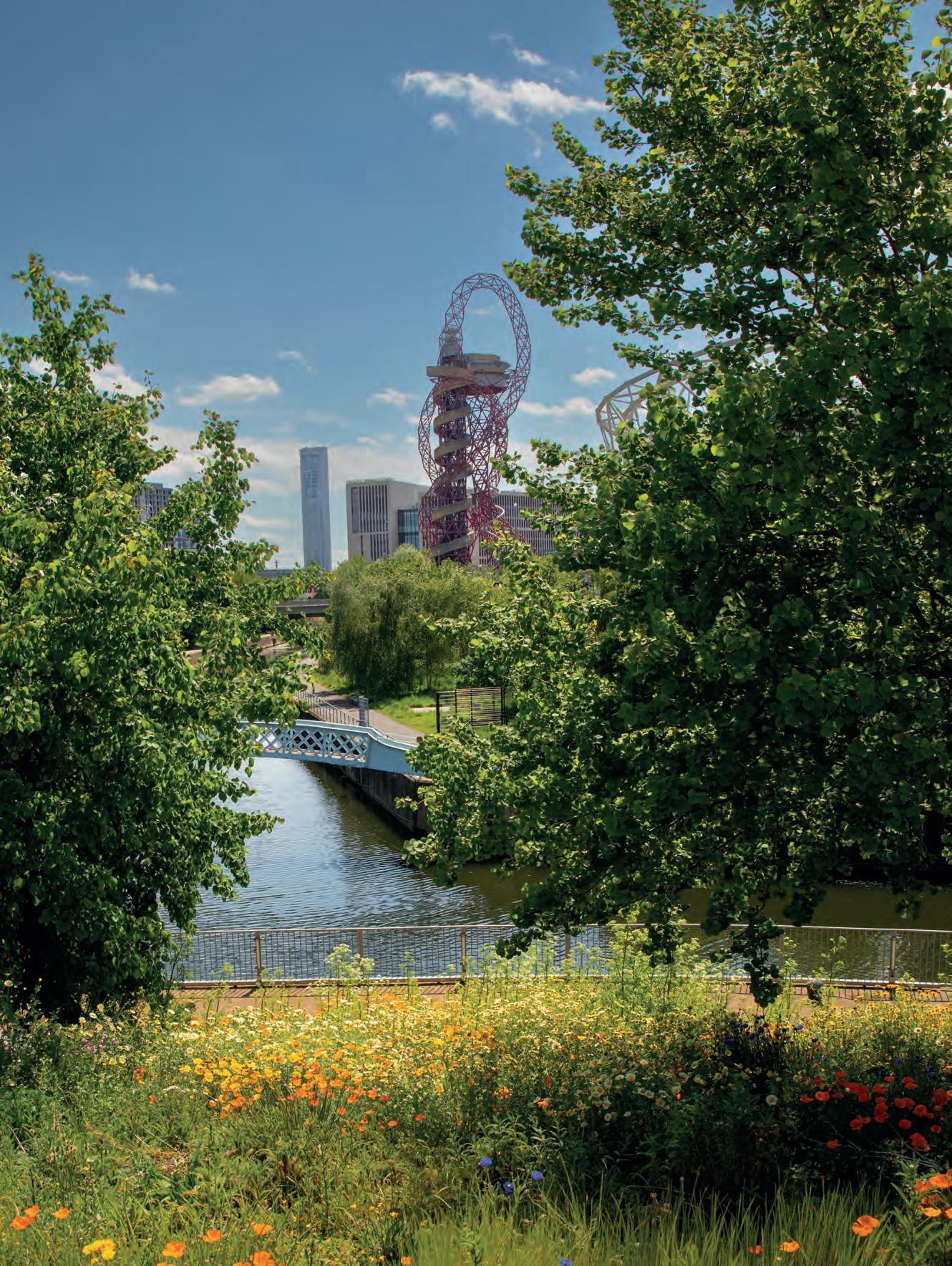

LET’S HEAR IT FROM Aidan Bell, idverde
PRO LANDSCAPER PROJECT AWARDS 2025 winners announced
HANDS-ON HERITAGE Tony Benger Landscaping celebrates 40 years

AUGUST 2025


LET’S HEAR IT FROM Aidan Bell, idverde
PRO LANDSCAPER PROJECT AWARDS 2025 winners announced
HANDS-ON HERITAGE Tony Benger Landscaping celebrates 40 years
THE NEW BIODIVERSITY ACTION PLAN FOR THE QUEEN ELIZABETH OLYMPIC PARK


Eljays44 Ltd, BizSpace, Courtwick Lane, Littlehampton, West Sussex, BN17 7TL Tel: 01903 777 570
Deputy editor – Bethany Vann bethany.vann@eljays44.com Tel: 01903 959 394
Editorial assistant – Holly Chapman holly.chapman@eljays44.com Tel: 01903 959 407
Editorial assistant – Elliot Armstrong elliot.armstrong@eljays44.com Tel: 01903 777 570
Senior subeditor – Katrina Roy katrina.roy@eljays44.com Tel: 01903 777 570
Senior designer – Kara Thomas kara.thomas@eljays44.com
Sales executive – Ollie Finch ollie.finch@eljays44.com Tel: 01903 777 579
Horticulture Careers – Ollie Finch ollie.finch@eljays44.com Tel: 01903 777 579
Managing director – Jamie Wilkinson jamie.wilkinson@eljays44.com Tel: 01903 777 589
Divisional director – David Griffiths david.griffiths@eljays44.com Tel: 01903 777 570
Content director – Nina Mason nina.mason@eljays44.com Tel: 01903 959 393
Commercial director – Luke Chaplin luke.chaplin@eljays44.com Tel: 01903 777 582
Subscription enquiries – Ollie Finch ollie.finch@eljays44.com Tel: 01903 777 579
Printed by Stephens and George Ltd Published by ©Eljays44 Ltd – Connecting Horticulture. Pro Landscaper’s content is available for licensing overseas. Contact jamie.wilkinson@eljays44.com
Pro Landscaper is published 12 times per year by Eljays44 Ltd. The 2025 subscription price is £128. Subscription records are maintained at Eljays44 Ltd, BizSpace, Courtwick Lane, Littlehampton, West Sussex, BN17 7TL, UK. Articles and information contained in this publication are the copyright of Eljays44 Ltd and may not be reproduced in any form without the written permission of the publishers. The publishers cannot accept responsibility for loss of, or damage to, uncommissioned photographs or manuscripts.
Whilst every effort has been made to maintain the integrity of our advertisers, we accept no responsibility for any problem, complaints, or subsequent litigation arising from readers’ responses to advertisements in the magazine. We also wish to emphasise that views expressed by editorial contributors are not necessarily those of the publishers. Reproduction of any part of this magazine is strictly forbidden.
Pro Landscaper is proud to be an Accredited Supplier member of BALI
Pro Landscaper is proud to be an associate member of the APL

Here at Pro Landscaper, we’re never ones to sit still for long – to remain still is to move backwards as they say – and this year’s Pro Landscaper Summer Spectacular at the De Vere Horsley Estate in Surrey is a testament to that mentality, because why host one event in a day when you can host three?
We kicked off the day with our vibrant Summer Showcase – complete with delicious fresh pizza, a spirited tug of war competition, and classic fairground games that brought serious Grease (1978) finale vibes. Next up was the annual Pro Landscaper Project Awards, brilliantly hosted by the hilarious Thanyia Moore. We wrapped up the day in true summer style – singing, dancing, and celebrating late into the night at our much-anticipated Summer Party.
In the fast-paced world we operate in, it's easy to get caught up in the momentum – but moments like these remind us to pause and truly appreciate not just our incredible community, but the exceptional talent and dedication within it. A huge congratulations to all those who were shortlisted and to the well-deserved winners (page 10).
See you at next year’s Summer Spectacular!

15
Hands-On Heritage
Growth, commitment and ambition; Tony Benger reflects on the last four decades as his company celebrates its 40th anniversary
27
Let’s Hear It From...Aidan Bell idverde welcomes in a new chapter focused on people, purpose, and the power of green careers with the introduction of new CEO, Aidan Bell
42 In Conversation With Landscapeplus Sam Cox on how the company is continually evolving and driving the brand forward with a greater emphasis on its people and purpose


33
Modern Tranquillity
Raine Garden Design shares how it transformed a disused farmyard into a space retrofitted for entertainment and play
37 Coastal Calm
Come wind or shine, sink into this seaside evergreen and drought tolerant oasis designed by Rachel Goozee Garden & Planting Design
45 A Moment for Peace
Nurturing young minds through the care of biodiversity; how McWilliam Studio created this school yard sanctuary in Old Amersham
The Wild, Wild East
Even with the biodiversity crisis and millions of vistors every year, Queen Elizabeth Olympic Park is still finding new and rare species across its site
65
Word to the Water Wise
In the face of a changing climate xeriscaping is increasing in popularity. But what else does this style have to offer?
72
All hands in: The planet needs it
Biodiversity, accessibility, and community engagement – Oli Haden from Walworth Community Garden discusses all three

26
Celebrating Welsh Slate
Gareth Wilson delves into the benefits and potential of Penrhyn Welsh Slate – as seen in his latest award-winning show garden
80 Influence
With great influence, comes great power –Lewis Normand urges us to spend this formidable currency with great care
83
Five Minutes with Mike McMahon and Jewlsy Mathews
Off the back of a victorious run at RHS Hampton Court, Mike McMahon and Jewlsy Mathews discuss The Subaru Cocoon
10
Pro Landscaper Project Awards 2025
Missed our hottest – in the literal sense –show of the year? Catch up on the winners, including this year’s Supreme Champion
21
Biodiversity Net Gain: What’s The Latest?
Keeping up with biodiversity net gain can be challenging – here’s the latest you need to know about the nature-fronted legislation


81
Comeback Kings
Humaira Ikram returns with another bold choice in her resurgent series – the self-declared controversial Leycesteria formosa. Is it time for a renaissance?



Anew Garden for the Future has opened at Sheffield Park and Garden in East Sussex, marking the Grade I-listed landscape's first ‘major’ land-based regeneration in over 70 years.
The new garden, designed by landscape architect and garden designer, Joe Perkins, will be used to observe and track how new and old species respond together in their new environment.
“It’s a kick starter for how we can adapt historical gardens to be able to cope with the challenges we’re going to face in the future climatically”, says Perkins.
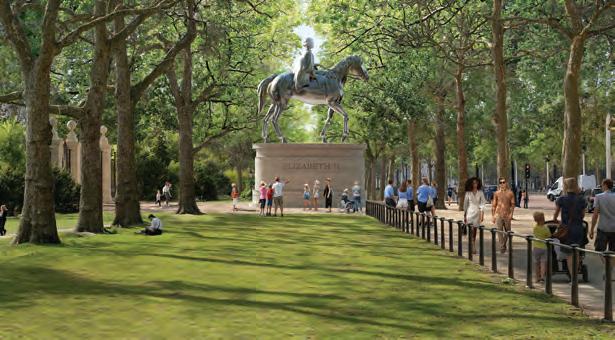
Foster + Partners’ winning design for the national memorial to Queen Elizabeth II will be situated in St James’ Park.
The team has designed a Prince Philip gate, new gardens and a translucent bridge inspired by the shape of the late Queen’s wedding tiara.
To celebrate the longest reigning monarch, there will also be a traditional statue dedicated purely to the late Queen Elizabeth II within the park.
Lead architect and founder of Foster
+ Partners, Norman Foster comments: “It is an honour and a privilege for our team to be awarded this project. Her Majesty loved history and tradition, so this is reflected in the inspiration of the original design of St James’ Park.”
The budget is predicted to be between £23m and £46m, with no completion date yet, and the final design plans are expected to be released in April 2026. fosterandpartners.com
The project aims to influence future design adaptations in the surrounding 120-acre garden, which has been in the National Trust’s care since 1954.
At an exclusive tour of the new climate mitigation garden, Perkins notes that the design, while respectful of the site’s heritage, is progressive in nature, with a strong theme of sustainability and climate resilience.
The landscape build for Garden for the Future was delivered by The Landscaping Consultants, with plants supplied by Kelways Nursery in Somerset. nationaltrust.org.uk

Formerly Outdoor Living Gardens – the garden design and landscaping company – has rebranded itself as The Outdoor Living Collective, as well as announcing the opening of its very first showroom.
Located in Ilkley, West Yorkshire, The Outdoor Living Collective flagship showroom will celebrate its grand opening on 25 July 2025.
John Tallis, managing director, comments:
“We believe gardens should be an extension of your home, a space you can enjoy all year round. With the opening of the showroom, it brings that vision to life and gives prospective clients a place to come and be inspired.”
The company’s evolution combines outdoor living under one cohesive brand, offering design and build in addition to furnishing, styling and maintenance.
The new showroom will offer homeowners a chance to chat through product and service examples with the team.
Visitors are invited to attend its opening event later this month, starting at 5pm. outdoorlivinggardens.co.uk
The Landscape Institute (LI) has launched a new five-year corporate strategy, focused on supporting landscaping professionals to deliver value for people, place and nature.

Connecting People, Place and Nature: Corporate Strategy 2025-30 has been developed through member consultation, diverse workshops and sessions with the LI’s council. The strategy has set out three strategic outcomes

New research published by environmental economics consultancy, Eftec reveals that 86% of approved planning applications have already claimed biodiversity net gain (BNG) exemptions in the legislation’s inaugural year. Commissioned by The Lifescape Project and Wildlife and Countryside Link, findings show that figures could potentially rise to over 95%. The consultation, which aims to improve the implementation of BNG for minor, medium, and brownfield sites, proposes an exemption of all small developments from BNG requirements.
It also looks to explore the revision of the de minimis exemption, which excludes developments that do not impact priority habitats and have minimal on-site habitat loss. eftec.co.uk
Keep up to date with the @ProLandscaper team over on Instagram!

to achieve by 2030, which include recognising landscape-led approaches as essential for delivering sustainable solutions to societal and environmental needs.
Carolin Göhler, president of LI, says: “With a strong vision, our members will be able to work together to support the success of the landscape profession.” landscapeinstitute.org

AGrade II listed Victorian viaduct in Castlefield, central Manchester, has been awarded £2.75m for a major extension, the National Trust has announced. The viaduct's ‘sky park’ will be over double in size, introducing winding paths encouraging visitors to walk more slowly extending the viaduct from 150m to over 350m.
Hilary McGrady, National Trust director-general, says this will work to “bring nature and green space to communities across Manchester”.
The viaduct was opened to the public in July 2022. However, an estimated £500k shortfall in funding is still required to cover the costs of the planting scheme. nationaltrust.org.uk

PUT THESE SUNGLASSES ON AND POSE
We’re still buzzing from what was an incredible night at the Pro Landscaper Summer Party!
Head to prolandscapermagazine.com


7 HIGHLIGHTS FROM PRO LANDSCAPER’S SUMMER SPECTACULAR
On one of the hottest days of the year so far, Pro Landscaper hosted its first Summer Spectacular at the De Vere Horsley Estate in Surrey.


YOUNG DESIGNER SPOTLIGHTS QUEER REFUGE IN RHS DEBUT GARDEN
Jacopo Ducato Ruggeri makes his debut at RHS Flower Show Wentworth Woodhouse with the Dune Garden – reimagining sand dunes on Fire Island, NY, known for its LGBTQ+ community.


EMMA HINDLE ON “GIVING BACK TO NATURE” WITH GROUND CONTROL
Ground Control’s newly promoted business development director, Emma Hindle, talks about the importance of working towards something that “actually makes a difference”.

From exploring its latest innovations, it was a day full of insight and inspiration.

COME
Delve into an incredible array of show gardens, where creativity, passion, and planting are all next level.
Marking the end of the show's over 30-year continuous tenure at the historic grounds of Henry VIII’s vista, this year’s RHS Hampton Court Palace Garden Festival had its share of memorable moments, from recordbreaking temperatures to the introduction of new garden categories. Marking the end of an era, the gardens at this year’s show told stories of climate resilience, adaptation and perseverance. Mike McMahon and Jewlsy Mathews’ swept the scoreboard, paying homage to the UK and Ireland’s dwindling temperate rainforests in The Subaru Garden (read McMahon’s response to the garden’s multiaward win on page 83). While the public fell in love with the tale of 19th-century Spanish feminism in Nilufer Danis’ The Three Graces Galicia. From a feline paradise and a warming sensory retreat to grey water harvesting, balcony gardens debuted, offering accessible small space inspiration.
So, while we're saying a temporary farewell to the show as it moves to become a biennial event – alternating between Hampton Court Palace and the Badminton Estate – it is hoped this ground rotation will breathe new life into the July show; attracting new talent and with it a renewed sense of intrigue; something the show has arguably been missing in recent years.


Good








9 HIGHLIGHTS FROM HAMPTON COURT PRESS DAY
Press day for the RHS Hampton Court Palace Garden Festival was a scorcher, with temperatures soaring past 30°, but did the Royal Horticultural Society leave us eager for its return?


RHS HAMPTON COURT 2025: GOLD MEDALS REVEALED
RHS Hampton Court Palace Garden Festival 2025 has given out five Gold medals, four Silvergilt medals, eight Silver and one Bronze across all categories.


















THANK YOU TO ALL OF OUR PARTNERS SUMMER SHOWCASE PARTNERS AWARD PARTNERS




















BUILD UNDER £50,000 CONTEMPORARY COURTYARD KIRMAN DESIGN


SPECIAL FEATURE UNDER £50,000 SANCTUM POD KALKSCHMIDT LANDSCAPE & GARDEN DESIGN



PLANTING DESIGN UNDER £25,000 SW4 - FERNDALE



DESIGN UNDER £50,000 CONTEMPORARY EXOTIC GARDEN STOCKLEY LANDSCAPE & GARDEN DESIGN









BUILD
£50,000 - £100,000 THE ARCHES JDS LANDSCAPES

SUSTAINABLE GARDEN UNDER £50,000 THE MEANWHILE GARDEN THE BETH CHATTO GARDENS

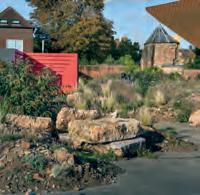


TEMPORARY INSTALLATION UNDER £50,000 SANCTUM KALKSCHMIDT LANDSCAPE & GARDEN DESIGN


DESIGN


DESIGN
£50,000 - £100,000 THE TRANQUIL GARDEN ROSEMARY COLDSTREAM GARDEN DESIGN

BUILD
£100,000 - £250,000 STONEHILL FORMOSA LANDSCAPES

£100,000 - £250,000 EATON SQUARE TERRACE & BALCONIES MAÏTANNE HUNT



DESIGN AND BUILD UNDER £50,000 E1 EAST ARBOUR ST GRDN LANDSCAPE + GARDEN DESIGN


SPECIAL FEATURE - WATER UNDER £50,000 AQUA EDEN DESIGN STUDIO AND WATER GARDEN CENTRE DU WATERSCAPES






















Tony Benger reflects on four decades of growth, commitment, and green ambition as the company celebrates its 40 th anniversary
WORDS: ELLIOT ARMSTRONG
Forty years ago, in 1985, Tony Benger spent two weeks undertaking landscaping work for his mum, it didn’t last very long. Fast forward to 2025, with a team of over 140 employees, his landscaping company – Tony Benger Landscaping – reports a turnover of £9.5m, is a recognised name across the industry, and is the recipient of several industry awards, including multiple Pro Landscaper awards. This was certainly not part of the script, explains Benger as he reflects on the changes to his life and
business in that time. “I was literally a one-man band with small ambitions. I had a Mini, borrowed a wheelbarrow, and off I went. A lot of water has gone under the bridge since then.”
Benger began his trade with subcontracts to his mother and vice versa, despite still studying at the time. It wasn’t long before he expanded, taking on two students. “We worked four days a week, because one


day a week we were still going to college together”. One of the toughest steps Benger faced was hiring his first member of staff –quickly realising that bringing on even one new person came with serious pressure. “One people to two means you have to double your turnover overnight,” he reflects. But that small team laid the groundwork for something much bigger. Benger set the tone early –work hard, take pride in what you do, and never cut corners. With such a tight-knit group, there was nowhere to hide and plenty of drive to innovate and improve. “Some people are better than others – but we don’t like shirkers,” he says. This makes the process of selection – and ultimately, succession – “almost selfselective”, Benger claims.
“The biggest milestone after that was four to five employees, because of health and safety and VAT registration. But after that, we just got bigger and bigger. Years ago, we would get very busy in the summer, taking on four or five extra young people to help with the workload. Then autumn
would come and some of them would go back to college, and such a reduction in effort would have a big impact. But when we had so much work coming out of our ears, we just had to take on more employees.”
It is this never say no attitude, Benger believes, that is accredited to the successes of Tony Benger Landscaping. Despite primarily being based in Devon, Somerset and Dorset, he’s never been one to turn down a job just because it was further afield. Especially with longstanding clients and facilities management companies who need trusted teams across multiple sites. “It’s driven by our customers,” he explains. “They ask, ‘Could you do this one? And that one too?’ So, we go where they need us.” That approach took the business into Swindon, Gloucester and North Bristol. When a big customer, some several years ago, bought multiple sites in Cornwall, Benger – despite the distance between East Devon and Cornwall – did not want a rival taking his place, and moved a couple of the team down there. The fact that the customer never built any more houses in Cornwall wasn't a deterrent; rather, it was an encouragement to expand.“It was too late to leave by that point, once we were set up and running”.

25, and its proximity to Exeter allows for easy collaboration across projects when needed. “It’s worked out brilliantly.”
That adaptability, Benger believes, is what gives the business its edge. “There’s always a plan,” he says. “And because of our size now, if a project falls behind, we can pull staff from all departments and get it done.”
He recalls one particular project where the build fell behind – not the landscaping, but the main construction.

His team was contracted by engineering company, Balfour Beatty. “It was a big job, and they needed it finished very quickly at the final push. Even in our busy period, we pulled people from lots of other departments, and we got it all done on time. That tells me everything I need to know about my hardworking staff. The ethos has always been to do a good job and give good customer service.”


Tony Benger Landscaping is founded with a spade and a borrowed wheelbarrow.
Tony buys a secondhand computer –marking the company’s first step into digital record keeping.

turnover, almost double the £5m just five years prior in 2021.
One big advantage Benger believes he holds is the company’s on-site nursery, allowing for plant care in the instance of delays, and a service he says sets the company apart. “We can look after plants and keep them ready for developers. It makes such a big difference to have [plants] in-stock, ready to go. Sometimes, things can go wrong and if you’ve already ordered the plants, you have to look after them, which isn’t always easy in this lovely British weather," he jokes.
My door is always open, and people love bouncing ideas off me, and to hear my experiences. It’s nice to be able to give people a sense of reassurance once an idea has been discussed

Such is the drive for client satisfaction – Benger has delved into areas of landscaping he admittedly doesn’t find as exciting himself. The business has seen strong, steady growth across all departments – with commercial landscaping and grounds maintenance both expanding significantly in recent years. In 2025, the company reports a £9.5m
While the company has grown beyond what Benger envisioned, he is insistent on retaining that original family culture. After the support of his mum in the early years, Benger's sister joined as a garden designer – and it wasn’t long before it became a full-time role. Before long, he was

Tony Benger Landscaping becomes incorporated.
working with five relatives. “It wasn’t a conscious decision,” he admits. “But it makes things easier – you’ve all got each other’s best interests at heart.”
In 2023, 80% of the company was sold to four employees, including his daughter Olivia. “I didn’t want to lose my top management, and I wanted to give my daughter a future.” A decision he says has allowed him to tentatively take a small step back from the business. “I’ve moved to a four-day week – and only get paid for four,” he laughs. This allows Benger to remain hands-on at the company he loves, but also time to do the things he enjoys – one of which is what he describes as “old man

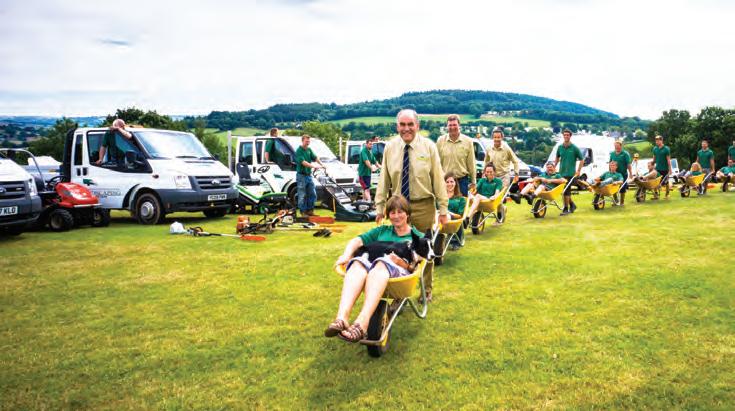
White Lodge yard is purchased, and the first telescopic handler joins the fleet.
A second office and workshop are built at Burrow Farm Gardens.
Company reaches its first £1 million turnover.
Cornwall yard opens. The business purchases the 14-acre Dalwood Hill Nursery site.
skiing”, on trips to France and the US. “My door is always open, and people love bouncing ideas off me, and to hear my experiences. It’s nice to be able to give people a sense of reassurance once an idea has been discussed and we come to a conclusion. We try and make the decisions between us.”
On Friday 18 July, the company marked its 40th anniversary in true Benger style –with a day full of stories, competition and celebration. It began with a company-wide meeting – no small feat with over 140 staff.
The foundations are there, the culture is strong, and that’s what matters most
A new meeting room was built back in 2019, but by the time covid passed, it was already too small. Benger kicked off the day by telling the story of the business –from that borrowed wheelbarrow to memorable moments like helping out on Euro Disney and receiving the 2018 EU grant that transformed




a chicken farm into a modern HQ. The afternoon brought knockout games in teams of five – because that competitive streak never really leaves – followed by an evening of music, drinks and plenty of laughter. “It’s always been important to me

that this is a rewarding place to work,” Benger concludes. “I might miss being on the tools now and then – but I trust the team to carry things forward. The foundations are there, the culture is strong, and that’s what matters most.”


Tony Benger Landscaping is awarded the EU Rural Development grant and takes on 48 new team members.
Re-flow field management software, allowing staff to track progress more efficiently while on the go.
£5 million turnover reached; the team hits 100 members.
Tony sells 80% of the business to four employees, including family members.
Celebrating 40 years in business, with 140 employees and a turnover of £9.5 million.

The London Square Chelsea Pensioners Garden, designed by Dave Green for RHS Chelsea Flower Show, has been relocated to the Royal Hospital Chelsea to be used as a daily dose of nature for the Pensioners
WORDS: HOLLY CHAPMAN
Apassion for wellbeing gardens, Dave Green has repeatedly championed the importance of nature for mental health. For this reason, the London Square Chelsea Pensioners Garden finds a home at the Royal Hospital Chelsea (RHC) for the Chelsea Pensioners to use throughout the year.
What was once a barren grassland, Green and his team have transformed The Prince of Wales Courtyard into a space filled with tall trees, over 2,000 plants, shrubs and a social seating area made from York stone and British oak arches. Positioned right next to the Chelsea Pensioners' new activity building, the space has the potential to be used a lot.

From pottery to woodwork and sewing to sea glass artwork, the activity building houses the Pensioners’ favourite hobbies. Now, paired with the garden, the area has plenty to offer. Green describes the open space as more than a garden: “The garden is just a setting for

enjoying this social space and for the interactions they can do in here, which they could never do before.”
What does it mean to the Chelsea Pensioners?
Home to soldiers broken by age and war, King Charles II established the Chelsea Pensioners and officially opened the doors of the RHC in 1692. Over the years, several elements of the grounds have been restored and modernised. Equipped with residential ‘births’, the grounds are home to nearly 300 pensioners in total. Archie Ferguson, age 87, expresses his gratitude to Green and the
team for developing a garden for the Chelsea Pensioners. “We’re really going to enjoy this garden with our friends and families,” he says. Decked out with a wooden seating area, supplied by The King’s Foundation Snowdon School of Furniture, the Pensioners have a place to chat, reflect or play games. Not only this, but the foundation has also embedded a map within the table, encouraging pensioners’ to recall their service and travel across the world.
A wave of red spills over the garden, whereby the seating upholstery and cushions have been specially made by prisoners’ rehabilitation charity, Fine Cell Work, using recycled ceremonial pensioners’ uniforms. Iconic to the retired veterans, passersby can immediately recognise where those uniforms have come from.
The slightly sunken social area has been specifically designed for accessibility, so wheelchair users are able to make use of the garden as well. Green says the garden is, “accessible, sustainable and sociable to help improve wellbeing and embrace their love of gardening and being outside.”
Ferguson also recognises the positive impact gardens can have on a person’s well-being, both physically and mentally.
Green and his team have transformed
The Prince of Wales Courtyard into a space filled with tall trees, over 2,000 plants, shrubs and a social seating area made from York stone and British oak arches
According to Green, “being outdoors makes me feel so good that I want other people to experience that as well.”
Mental health organisations such as the Mind charity also preach about the benefits of

gardening, exercising outdoors and being surrounded by nature. The charity advises spending time outside can improve one’s mood, reduce feelings of stress and improve one’s confidence and self-esteem.
General Sir Adrian Bradshaw, governor of the RHC, describes the space as a “special bit of garden design,” which has been built as a focal point for not just the pensioners’ but for the staff and visitors, too.
Sponsored by London Square, the garden follows its commitment to develop a sense of community with every development. Chief executive Adam Lawrence says Green has created a “magical space” that has created a “hugely rewarding experience” for the pensioners. Green worked with both London Square and the pensioners when he was designing the garden, aiming to reflect the 333-year heritage of the RHC.
Green looks forward to autumn, when the garden will be a sea of oranges and yellows, something he hasn’t seen yet, while the garden was initially designed using a spring/summer palette for RHS Chelsea.
As the landscape architect and garden designer finish up one project, he moves to the next. RHS Wisley will be home to the Greener Skills Garden, intended to encourage new people to delve into the world of horticulture.

From proposals, consultations, and push backs –biodiversity net gain is continually changing, here’s where we currently stand
Since its rollout early last year, biodiversity net gain (BNG) has continually been thrust under the microscope. A legislation of such proportion is arguably always going to have some kinks in need of ironing, and it could be all too easy to fall behind on the latest changes, many of which seem to have been in the last couple of months alone.
In the last week of May, the UK labour government put forward its plans to streamline small site planning processes in what it called ‘urgent action’ and cited the current system as ‘too difficult’ for small builders to break ground, noting a lack of equality in the barriers placed on small and large sites alike. Figures released by the Home Builders Federation revealed planning permission for new homes in England during the first quarter of 2025 was at an all-time low since records began some 20 years ago – beating out the COVID-19 stall for the top spot. To remedy this, the government put forward the following proposals:
• Ease up on biodiversity net gain requirements for small sites – classified as nine homes or less – with the expectation that planning would become streamlined, with faster decisions being made by planning officials instead of committees.
• The introduction of a new ‘medium site’ category; when BNG was introduced, it was done so with three categories: small and large sites and national significant infrastructure projects; this new 10 to 49 home category will look to fill that equality gap with a set of simplified BNG rules and exemption from the Building Safety Levy, both in the hopes of improving the delivery of biodiverse habitats on-site and again streamlining planning processes.
• Increased financial opportunities and land availability for SMEs: If approved, this will see Home England release more of its land exclusively to SMEs, as well as a new National Housing Delivery Fund is shortly to support long-term finance options
• Brownfield small site pilot for SMEs: the Small Site Aggregator looks to attract private investments to build new social rent homes and develop otherwise disused brownfield sites to address temporary accommodation challenges.
It was also announced that the government would be making a further £10m in funding available this financial year to support local planning authorities implement BNG. Collectively these proposals are designed to address the housing crisis and enable the government to meet its target of building 1.5m new homes within the current parliament.
In
the time since it was launched the legislation has created over 450 new full-time green jobs, with over 800 contractors engaged across the sector
While the proposals are looking to streamline planning and effectively get Britain building again, they were met with varying resistance, with the chief executive of The Wildlife Trusts, Craig Bennett calling the proposals a ‘disappointment’ and highlighting that if BNG was to be scrapped for small sites it would undermine the companies who have already invested in its delivery.
On the same day the government announced these proposals it also launched an open consultation, titled: ‘Improving the implementation of biodiversity net gain for minor, medium and brownfield development’; inviting people to share their thoughts on exactly that – how BNG can be implemented.
Within the consultation were options centred around extending exemptions, simplifying the small sites metric, and increasing ease of access to the off-set habitat unit market – as well as challenges regarding brownfield development; the consultation closed on 24 July.
Another open consultation around BNG for nationally significant infrastructure projects (NSIPs) was also launched on the same day. BNG for NSIPs was originally intended to roll out in November this year but has since been pushed back to May 2026, which the government says is to ensure a clearer framework is in place ahead of its introduction.

A new report released in July, which draws on results from 33 Habitat Bank operators across England revealed the BNG policy to be a ‘rapidly’ scaling market forecast to reach a three billion pounds retail market value by 2035, by which time it also predicts over 91k BNG units to be created. The data shows that in the time since it was launched the legislation has created over 450 new full-time green jobs, with over 800 contractors engaged across the sector.
Much like its kinks, the legislation also came with its own set of loopholes; some of which have been recognised and brought to attention. In July a new report published by environmental economics consultancy, Eftec, it was revealed that 86% of approved planning applications had already claimed BNG exemptions during the legislation’s inaugural year.
Public understanding of the nature-fronted legislation remained low, with only 3.1/10 underscoring the need for broader education and awareness
It did however also record that public understanding of the nature-fronted legislation remained low, with only 3.1/10 underscoring the need for broader education and awareness.
In the findings, by The Lifescape Project and the Wildlife and Countryside Link, it shows this figure could rise to over 95% if the proposals put forward are approved and existing loopholes remain unaddressed.
Again, it is only natural that a legislation of this size be continually changing in its infancy, but the way it changes and how those changes are communicated are fundamentally in its execution – which when many of your most important habitats are classified as ‘poor’ - like the UK – it's even more important we get it right.






Andrew Duff invites you to the Society of Garden + Landscape Designers Sheffield Symposium taking place this October
We are thrilled to announce an exciting new addition to the design calendar: the upcoming SGLD symposium, Extreme! Designing Sustainably for a Changing Climate, which will take place in Sheffield this October. This two-day event will bring together leading voices in sustainable landscape design, horticulture, and urban regeneration from across the globe, with a rich programme of keynote talks, site visits, panel discussions, and networking opportunities.
At the heart of the symposium is the urgent question of how garden, landscape, and urban designers can play a pivotal role in addressing the climate crisis. Through innovative practices, thoughtful material choices, and communityled solutions, professionals in our field are increasingly finding themselves at the forefront of environmental stewardship.
actively contribute to climate mitigation, on the scale of private gardens, public landscapes, and entire communities. Delegates will hear from a roster of international experts offering insight across regional and global contexts.
At the heart of the symposium is the urgent question of how garden, landscape, and urban designers can play a pivotal role in addressing the climate crisis
The event will explore how design can not only adapt to a rapidly changing climate but
Breaking away from the London-centric tradition of design events, the symposium will be hosted in Sheffield, one of the UK’s most exciting cities for urban regeneration and landscape innovation. The beautiful Art Deco Sheffield City Hall will serve as our venue on Friday 17 and Saturday 18 October 2025, offering a stunning backdrop to what promises to be an inspiring and thought-provoking gathering.
Day one opens with guided site tours showcasing some of Sheffield’s most progressive and award-winning regeneration projects. Attendees will visit key urban landscapes and green infrastructure schemes, including the acclaimed “Grey to Green” corridor – an exemplar of climate-responsive urban design and explore the work of the visionary community interest company Green Estate
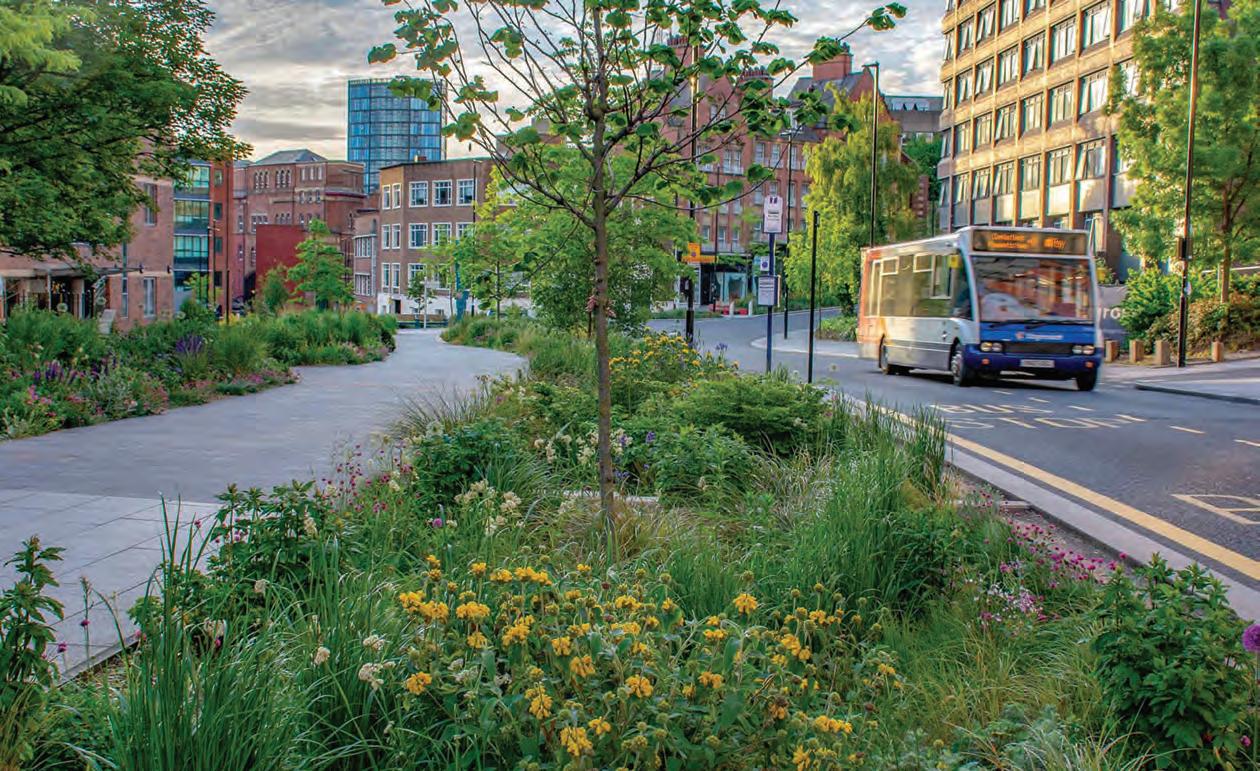
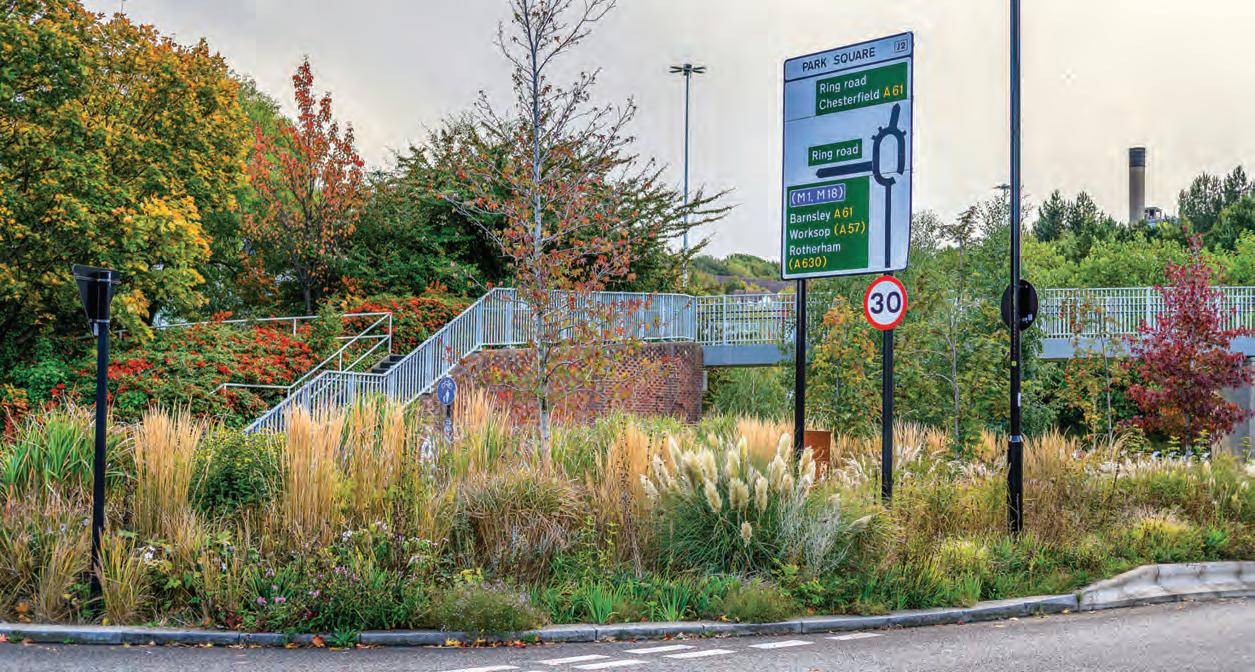
Site visits will also include an in-depth look at Pictorial Meadows, which shows how cutting-edge plant selection and long-term maintenance strategies have transformed public spaces across the UK. These tours will be led by the very designers, engineers, planners, and horticulturalists responsible for the transformation of these spaces, offering invaluable real-world insight into sustainable placemaking in action.
The day concludes with an informal evening gathering at City Hall. Featuring a keynote talk from the respected ecological gardener John Little, the social event includes a hot buffet and bar – an ideal setting for relaxed conversation and meaningful networking among delegates, speakers, and industry professionals.
Saturday’s full-day symposium, chaired by Errol Fernandes, head of horticulture at the Horniman Museum and Gardens, features a world-class line-up of thought leaders, practitioners, and researchers at the cutting edge of sustainable landscape design. Confirmed speakers include, Nigel Dunnett, professor of Planting Design and Urban Horticulture at the University of Sheffield, Tom Massey MSGLD, designer and author, Loretta Bosence, sustainable materials pioneer, Graham Dillamore, head of horticulture at Historic Royal Palaces, Haruko Seki MSGLD, awardwinning Japanese garden designer, Jihae Hwang, South Korean ecological designer and John Little, ecological garden specialist.
Site visits will also include an in-depth look at Pictorial Meadows, which shows how cuttingedge plant selection and long-term maintenance strategies have transformed public spaces across the UK
tackle key themes such as adapting landscapes to extreme weather events, designing with nature, and embedding sustainability in both process and practice. The panels will feature Will Thomson, founder of Creative Cultivation, Alys Fowler, horticulturist, journalist, and author and Andrew Fisher Tomlin FSGLD, renowned garden designer and educator. Audience participation will be encouraged throughout, fostering open, inclusive conversations that reflect the collective ambition of our field to lead on climate action. This symposium isn’t just a moment for reflection, it’s a practical investment for design professionals. Attending qualifies for 12 hours of Continuing Professional Development (CPD). A curated selection of trade stands will also be present at the venue, offering access to high-quality products and services aligned with sustainable principles.
Tickets can be found using the QR code below, with discounted rates for SGLD members, Affiliates, and Friends. Student tickets start at £138, and full member tickets from £235. A limited number of packages are available that include accommodation at the Radisson Blu, located in the city centre and hosting many of the speakers and panellists.
Whether you're a seasoned designer, emerging practitioner, educator, policymaker, or student, this event offers an exceptional opportunity to deepen your knowledge, expand your network, and be part of a growing movement towards climate-positive .

In addition to keynote talks, two lively panel discussions will

SGLD Symposium: Extreme! Designing Sustainably for a Changing Climate takes place on 17 & 18 October 2025. Scan the QR code to book tickets and for further information.
©MarianneMajerus

An internationally recognised garden designer, Andrew Duff MSGLD has been designing gardens for over 30 years. In addition to running his practice, he is managing director of the world renowned Inchbald School of Design and is Chair of the Society of Garden + Landscape Designers. sgld.org.uk
The team and I have just finished at RHS Wentworth, and we’ve had another great result, winning a Gold Medal, Best in Show and Best Construction awards for the RNIB Legacy Garden designed by Paul
Hervey Brookes.

We used many great hardscape products at Wentworth, but one deserves a special mention: Penrhyn Welsh Slate, which surely must be one of the best-known UK natural stones. This is the third time we’ve used Penrhyn slate. It includes paving, roofing slate, walling stone, aggregates or cladding (see below).
As many readers know, I’m passionate about paving, especially UK-sourced natural stone. I’ve said for years that the UK is underused, with mostly imported products used domestically and commercially. I don’t proclaim to be a stone expert, but I’m trying to gain more knowledge.

Off the back of his victory at RHS Wentworth, Gareth Wilson delves into the practical benefits and potential of Penrhyn Welsh Slate in UK landscaping
A Brief History of Penrhyn Slate
Penrhyn slate was formed around 500-600 million years ago in the Cambrian period and is one of the world's oldest and highest-quality slates. Slate started life as thin layers of mud, fine clay particles, and layers of sand and volcanic ash from underwater landslides, forming sediments on an ancient ocean bed. These layers of sediment built up, pushing the water out and forming mudstone.
The slate then went through the metamorphic phase around 450 million years ago with the collision of land masses, creating mountains, high pressure and temperatures of 300-450 degrees. Its mineral composition is chlorite, quartz, mica, feldspar, and hematite, which gives Penrhyn slate its purple hue. The green patches you often see on slate are where the hematite for whatever reason didn’t penetrate the silt and other minerals were more prolific.
Penrhyn slate can last in excess of 150 years on a roof, but it’s so much more than just roofing slate

Penrhyn slate is incredibly easy to work and cut, but due to its high silica content, full PPE and water cutting to suppress dust are a priority.

It’s largely known as a roofing product due to its ability to split into thin layers and its ultra-low water absorption. Penrhyn slate can last in excess of 150 years on a roof, but it’s so much more than just roofing slate.
Paving-wise, it most commonly comes in smaller slabs, 300mm x 500mm x 50mm, but larger slabs can also be manufactured (see above right). A bonding mortar is essential, in my view, to adhere the paving to the mortar bed. Due to its low water absorption, a wet mix alone would not be sufficient. I mention this to the naysayers of bonding mortar, who say it isn’t necessary for the natural stone brigade. A slurry grout would work incredibly well for grouting, too.
I see maintenance as very low, and although you can apply an impregnated sealant, I don’t see this as necessary at all unless it’s a shady area or near trees.
Penrhyn slate paving is another great British product, I think we should see a lot more of. I know there’s a need to import stone but always keep an open mind to UK sourced paving and natural stone, we have some of the best in the world.

GARETH WILSON
Leaving college at 17, Wilson has worked in the landscape industry since 1989. Progressing onto highend projects, he has picked up seven RHS gold medals. He is a member of multiple professional bodies. He provides technical and product advice to large companies, mentors and trains contractors and garden designers in landscape construction and on show gardens logistics across the UK. Gareth also provides mediation services, he is a member of the BS7533:102 committee and is an industry awards judge. gkwilsonlandscaping.co.uk
“TEENAGERS ARE NOW MORE AWARE OF THE IMPACT THE ENVIRONMENT HAS ON SOCIETY AND THE PLANET, SO HOW DO WE HARNESS THAT? HOW DO WE SHOW THEM THAT THE WORK WE DO EVERY DAY HAS A POSITIVE IMPACT ON THE PLANET?”


Aidan Bell’s arrival at idverde marks a bold new chapter focused on people, purpose, and the power of green careers
WORDS: BETHANY VANN
Addressing the skills gap has long been a pressing issue within our industry. It’s crucial not only for ensuring effective succession planning but also for injecting fresh perspectives and helping tackle today’s pressing environmental challenges. But perhaps the real question is, should we focus on closing the gap, or would bridging it be a more fitting approach?
Nearly two months into his new role, idverde’s CEO, Aidan Bell, is eager to shake things up and spark greater interest in land-based careers – especially among young people and those considering a career change, two scenarios he is familiar with.
“I didn’t go to university,” explains Bell. “Instead, I did an apprenticeship back home in Ireland. Then, when I was 22, I thought – what’s the big bad world got to offer out there?” That sense of curiosity and ambition sparked what would become a three-decade and counting stay for Bell. Originally planning to stay in the UK for just three months to earn some money on a building site before traveling on, he never expected to settle down here. "Thirty years later, I’m still here," he reflects. "I started out on construction sites in the southwest of England, which I really enjoyed. Then came an opportunity in project management, and things just evolved from there."
What began as hands-on work on building sites gradually shifted toward the operational and strategic side of buildings into the world of facilities management (FM). "There was never a definite decision to go into FM," he admits. "But it kind of happened naturally."
He went on to become managing director at Aramark for EMEA – Europe, the Middle East and Africa –which saw him take on full FM responsibilities for 32 countries. Managing services for clients like Nike, LinkedIn, and Google, Bell saw firsthand a shift in the industry's values. "It wasn’t about cost anymore; it was about the outcome of what the workplace delivers." A shift which he says will influence his journey at idverde, noting that developing a standardised delivery methodology through training is likely to result in more predictable outcomes. “That predictability of outcome comes in two parts... You get a quality service, but also financial outcome as well. With standard inputs you can manage the cost better, because whether we like it or not, it is a price sensitive market.”
How do we then tell them the advantages of being outside every day, working with sustainability, ecology, the environment. I think society needs to work on valuing manual skills more so than they've perhaps done in the past
Providing consistent quality of training is just one important pillar needed to support the metaphorical skills bridge – attracting people to the industry in the first place is another hurdle in itself. “How do we make apprenticeships interesting for school leavers?” Bell asks.

“That's a huge challenge for all manual labour sectors. How do we then tell them the advantages of being outside every day, working with sustainability, ecology, the environment.
I think society needs to work on valuing manual skills more so than they've perhaps done in the past.” The conversation around the industry and the career opportunities available has arguably gotten louder in recent years as more attention is brought on by the changing climate and environmental concerns, which Bell acknowledges. “Teenagers are now more aware of the impact the environment has on society and the planet, so how do we harness that? How do we show them that the work we do every day has a positive impact on the planet?”
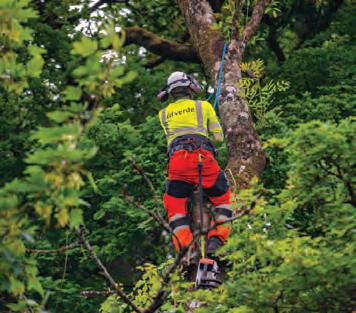
Within that conversation we’ve seen more emphasis placed on apprenticeships, as well as the introduction of T-Levels a couple of years back; all in an effort to create more access points to the industry. The conversation has, in recent years, expanded to include career changers and bring them into the mix – a group Bell himself acknowledges he is part of. He recalls the Covid-19 pandemic and subsequent lockdowns; “I think post pandemic


society has worked out the benefit of outside space. People have recognised the impact on mental wellbeing, physical health, all those things, from outdoor space and I think society now values it more.” Adding that his active lifestyle and recent dive into sustainability were also driving factors to his move to idverde. “Over the last probably five or 10 years, I’ve become really aware of the impact on ecology, sustainability, biodiversity, that outsourcing can have, and that's the services industry. Put those two things together, and a company like idverde has an opportunity to make a big impact in that area, and that’s what attracted me.”
Two months into the role, Bell has immersed himself not only in the industry but also in the company, exploring how his previous experience and skills can be applied to benefit idverde and its goals. “I'm not going to give you numbers and contracts and all that kind of stuff yet. Quite simply, I've got four priorities for the business that I’ve been talking about and working on...”
Health and safety
“We have a tagline for health and safety at idverde, which is ‘work safe, home safe’, and that is my number one priority. We have over 3,000 team members out there, we need to make sure that the environment we ask them to work in is safe for them."
Frontline first
“What that means is the individuals who have dirt under their fingernails, they're the ones delivering services on our behalf every day. The decisions we make can't be from our HQ in Coventry, we need to make
decisions that positively impact our frontline because that’s where the action happens.”
“For me, this is two things overarching. The reality is, I've got around 3,000 salespeople, so what's the employee value proposition? Why would somebody come to work for idverde? The retention and attraction of talent is hugely important too, we have to understand and be able to articulate what that employee value proposition is.
somebody mentions idverde, do they know exactly what we do, why we do it, and how good we are at what we do. There's the legacy of our grounds maintenance work, but I genuinely think we have an opportunity to have a bigger and wider impact on society.”
growth
"We are a private equity backed private enterprise; we have commitments to financial outcomes and that order is a logical sequence to the four priorities.”
He regards his diverse background as an advantage, not only equipping him with a unique perspective, but his first-hand experience on the field affords him appreciation for the work the team does. “I hope people see that in my approach, my prioritisation and my interactions, that I get it. It's not an easy job and I understand that.” Adding that he hopes people will see the authenticity in his leadership – “they're not just words, they're my true personal values, and I can bring them to the business.”
I hope people see that in my approach, my prioritisation and my interactions, that I get it. It's not an easy job and I understand that
As the company moves from strength to strength, expanding its geographical reach and diversifying its portfolio of offerings, Bell is looking at how best to leverage the strength of that collective.
“The second one is the customer value proposition: what are we famous for? When
“If you think about the history of idverde, it's a series of acquisitions brought together. I'm not sure we've yet leveraged its full strength.” This, Bell says, will come from ensuring the companies that join

idverde brand are not siloed and moving towards a more matrix management system. “Post acquisition integration is something we always talk about – we talk about company synergies, the opportunities, the upselling, the cross selling and businesses use.” A good example of this methodology in practice, says Bell, is idverde’s acquisition of Acorn Environmental Management Group around this time last year. “Kevin O'Rourke was the owner and is still the managing director of that business – he's joined my leadership team and he's getting involved in a lot of stuff within idverde. That integration will drive benefits from that expertise, in quality and safety and in financial growth as well.”
I think post pandemic society has worked out the benefit of outside space. People have recognised the impact in mental wellbeing, physical health, all those things, from outdoor space and I think society now values it more
idverde has a long-standing presence in both grounds maintenance and landscaping, with the two disciplines frequently overlapping and working in tandem. While its roots lie in grounds maintenance, the company has also built a strong reputation in landscape creation, delivering a wide range of landscaping projects. Rather than one area replacing the other, idverde has broadened its service offering to fully integrate and deliver both. To date, idverde has acquired 12 companies, expanding its team ten-fold, but how then does it, as the saying goes, ensure everyone is singing from the same hymn sheet? Bell calls on the Leading Leaders

Development Programme which is aimed at equipping the team members with the tools, confidence, and connections to lead with purpose. The programme includes workshops, interactive team building, career development sessions, and discussions on strategic thinking and SHEQ – safety, health, environment, and quality. The 12-month programme is designed in collaboration with the idverde leadership team and looks to drive a holistic approach to leadership development skills and foster deeper working relationships.
“It’s important to me that we understand our value proposition; we’re experts in grounds maintenance, landscaping, and play area creation, but also that we have a full understanding of the impact we have on
communities, sustainability, social value, and social mobility, and that's achieved in part through apprenticeships.”
As Bell settles into his role at the helm of idverde, his vision for the future is clear: build not just a stronger business, but a more connected, purposeful industry. His commitment to people – whether through apprenticeships, career transitions, or frontline empowerment –signals a shift from traditional thinking to a more holistic, inclusive approach.
Bridging the skills gap isn’t about simply filling vacancies; it’s about reimagining what the land-based sector can offer in a world increasingly shaped by environmental and societal pressures. By uniting expertise, values, and opportunity, Bell is looking to not only build upon idverde’s long standing heritage, but also secure its continuing presence in the industry.




Lacking soul and purpose, this once self-professed disused and unloved farmyard and factory was unfit for purpose for the needs of the young professionals who live there. Now the space poses as a high-quality modern extension of their home, designed with functionality, entertainment and dining in mind – giving the couple a now-loved split-level outdoor space for hosting and relaxing in.

To elongate the smaller space, the garden has been split into three distinct zones: a raised upper outdoor kitchen area, a lower central seating and relaxation zone, and an athwart lawn encompassed by planting.
Though not a new feature of this garden, the curved upper area was extended and connected with extra-wide shallow steps to ensure that, though it does stand above the rest of the garden, it remains connected to the rest of the space. An outdoor kitchen was established and a BBQ added here, where the extra height provides ample countryside views – perfect for entertaining – above fencing - leaving the raised terrace area not only as a stylish alfresco section where meals are devised but also a welcoming entrance for the outdoors where the family can remain connected to nature.
In the central area of the garden, the bold, modern pergola now sits by the newly fitted open-plan office and hot tub. A physical relationship between the three main features – the hot tub, office and pergola – was devised to ensure a natural flow to the space, with bespoke cedar

joinery providing a warm, homely yet simple feel to the central area. The roofed pergola adds a small seating area perfect for snug, relaxed gatherings following use of the raised BBQ area. The adjoined office area was designed as a doorless feature, again ensuring all parts of the garden feel connected, and a subtle water feature completes the serene seating setting. In the central relaxation area
stands a mature chestnut tree, which posed a potential challenge to the team due to the outstanding tree preservation order and root preservation order. Extreme caution was taken when working in this area to limit potential impact to the root system; this proved difficult due to the site’s farmyard history. High amounts of existing concrete could not be removed as not to disturb the complicated root system

below, meaning all paving laid was done so above ground to avoid disturbing the roots, and planning was coordinated with an arboriculture officer to ensure renovations were completed safely. Specific positioning of the hot tub and office room was also required to not disturb this concrete.
Planting was incorporated under the canopy of the chestnut tree, including pleached Carpinus Betula – a native species perfect for growth in well-drained soil exposed to the sun and popular among birds looking to nest. While scented roses encase the seating area and a scented climber was added to the pergola, creating a naturalistic design and offering a sensory experience to be enjoyed by the family and guests alike.
• Carpinus Betula
• Cenolophium denudatum
• Acer palmatum
• Saucer Magnolia
• Trachelospermum jasminoides
• Nepeta racemosa 'Walker's Low'
Beginning in natural drifts, the garden’s additional planting pallet is made up of species designed to mimic the surrounding landscape, tying the two spaces together and offering a tasteful but sensitive visual aesthetic to the garden. Evergreen species were chosen for their distinguished shapes and their ability to thrive in the colder months – creating year-round interest. For when the lighter nights come around, the Japanese maple Acer palmatum trees were planted for their striking red autumn foliage and the low maintenance
“Raine's knowledge of garden design and her way with people are quite extraordinary. Our garden was unloved, lacking soul and not a space we could enjoy as a family. We love entertaining but always felt confined to being inside when we had guests or parties. Raine opened our eyes to the world of garden design and worked with us to design an incredible outdoor space that we are not only immensely proud of but has changed the way we live.”





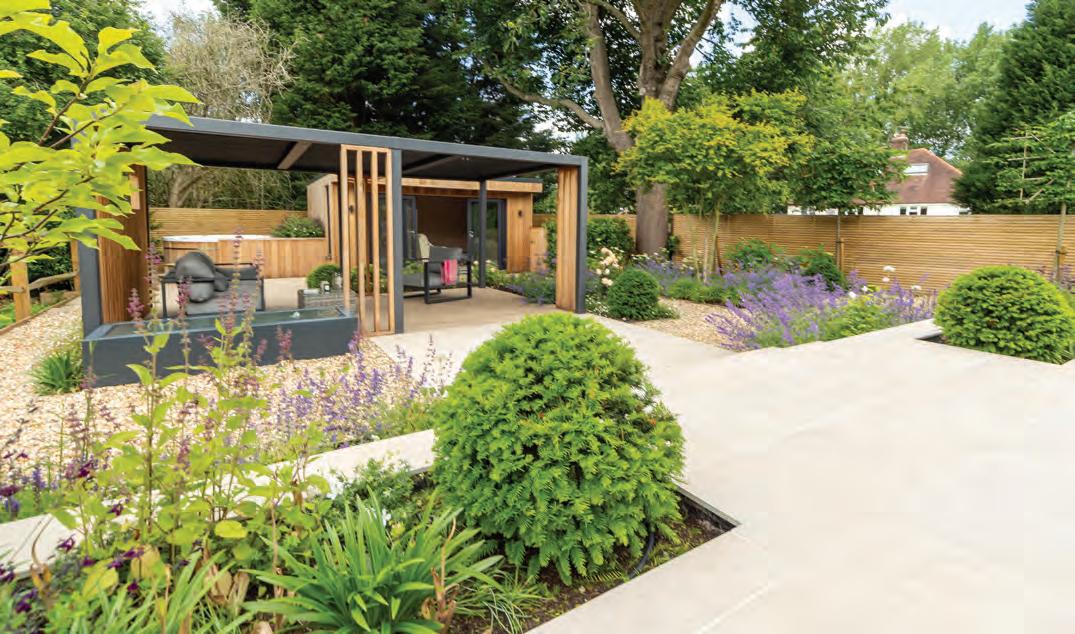
star jasmine Trachelospermum jasminoides was strategically positioned next to the hot tub for its strong fragrant summer scent.
Another of the client’s requests was for an area to be designed fit for their children to explore and play; this meant creating space for the future installation of a climbing apparatus and trampoline. Strong planting was a key feature to surround this grass area and the rest of the project to create a homely feel. Local flowers, such as herbaceous perennials, are used to affix the works to the local countryside, ensuring wildlife, in particular bees, can roam happily, ultimately creating a viable, sustainable environment. Next to these, the Baltic parsley perennial Cenolophium denudatum, loved by butterflies, provides a refreshing colour blend.


Despite the challenges faced by the team, the result is now a modern, cedar-inspired garden fit for a whole host of purposes and events for all the family and their guests. As well as giving them the space they wanted to engage and connect with the surrounding nature of their homestead.
Raine Garden Design is a comprehensive garden design consultancy to clients seeking a beautiful and functional outside space. It offers a range of services across the southeast including garden design, construction management, and detailed planting. rainegardendesign.co.uk
Contractor Winslade Landscapes winsladelandscapes.co.uk
Paving Kebur Garden Materials kebur.co.uk
Paving London Stone londonstone.co.uk
Pergola Suns Lifestyle sunslifestyle.com
Hot Tub
Urban Cedar Hot Tubs urbancedarhottubs.co.uk
Planting
North Hill Nurseries northhillnurseries.co.uk
Griffin Nurseries griifinnurseries.co.uk
Van Arnhem Nurseries vanarnhem-nursery.co.uk

RACHEL GOOZEE GARDEN & PLANTING DESIGN
LANCING BEACH FRONT AND REAR GARDENS
When Rachel Goozee was approached to develop the front and rear gardens of this new-build property in an ideal spot on the southern seaside, she knew the key to unlocking its potential was ensuring it found its coastal feel by providing warmth and durability. This was also the shared vision of the new owners, whose property was transformed through a mix of new hard landscaping materials to create a gravel garden
Limestone is king here with jura beige slabs mixed with small unit limestone stackers and five stunning Langton limestone boulders, all knitted together with the most wonderful purbeck gravel

adorned with a vibrant drought- and salttolerant planting scheme, creating a seaside haven – not only for themselves but also the local wildlife.
The physical alterations began with high amounts of permeable Purbeck gravel implemented in both the front and rear gardens, to allow for a sustainable water filtration system for the planting that would follow. In the corner of the rear garden, an old despondent shed was swapped for a more contemporary hot tub, protected by a new layer of pleached trees and leafy star jasmine, creating additional canopy cover. Opposite the new hot tub was a small gym, which itself has
had a refresh, with vertical cedar battens installed to replace the existing split slate cladding. Capitalising on the space between the two existing zones, a new seating area and an outdoor kitchen have been established, complete with a new Morso stove.
Limestone boulders surround the entertainment area to divide the space, lined with drought-tolerant shrubs to create an enclosed and biophilic atmosphere for guests. Elsewhere, a copper pipework shower sits neatly on a well-varnished timber panel –creating a complementary blend of vintage and modern styles – an essential installation for those post-sea swims. It hadn’t taken much


for the garden, which previously consisted more simply of a narrow-paved patio and a derelict lawn, to employ that homely feel for the couple.
Not wanting to add new features unnecessarily, Goozee knew exactly how she envisioned the remaining space to create a warm, coastal ambience, as she explains: “We wanted to leave 60% of the overall footprint for planting”. To the rear of the garden, a mix of heavy clay and shingle were used in addition to a new BS soil conditioner; the site’s existing soil was dug and overturned to improve drainage and aeration.
Careful consideration was given to the property's coastal location – most importantly, the replacement of the wind-battered boundary fence with breeze-friendly vertical hit-and-miss panel fencing, not only allowing air current to pass through naturally and mitigate future damage, but also providing a continuation of the new littoral overtones.
Being in close proximity to the beach means strong gusts of wind are never in short supply, making this garden no stranger to excess salt, a fact that influenced the garden's new planting scheme. Alchemilla sericata 'Gold Strike' flows

naturally and flourishes in the exposed conditions alongside drifts of salvia and thyme, with summer-seaside colours contrasting in the forms of Lavandula ‘Hidcote’. Oenothera lindheimeri 'Whirling Butterflies' add further pops of colour – its airy, butterfly-like petals provide a scintillating scent which is carried around delightfully by the whirling winds.
While the planting palette was chosen for its droughttolerant nature, it also bolsters the site's sustainability, requiring minimal watering and maintenance. Ground hugging plants sit between the newly-added gravel –their small leaves and long foliage keeping evaporation to a minimum, which can be essential in these conditions.

point of the front garden, brought in to cover the property’s unfavoured looming telephone pole – proved difficult, with the sloped driveway causing some complications. Once manoeuvred into its newly prepared tree pit, two Pinus densifloras were added, as well as evergreen coastal shrubs and radiant Hippophae rhamnoides to match the coastal feel in the back garden and to suppress the constant day time drum of traffic nearby from beach-dwellers.
1 Hidden and hugged front garden
2 New rear gravel garden in full view
3 Coastal tolerant & wildlife friendly planting
4 Enter the front garden
The front garden, which sees the most sun, posed a new set of challenges. Here, the previous soil was rendered redundant, as the old heavy concrete paving had rid it of the oxygen and nitrogen required for the new plants to thrive. Installing a striking Pinus nigra – the main focal

“I look out every day now and cannot believe the transformation. We have a garden teeming with life and the local birds, bees and butterflies are all grateful. The feel of the house has completely changed as we are now wrapped in something alive and beautiful. Rachel continues to support us even after the other contractors have long left the site. She helped us to find a qualified gardener, provided a maintenance guide for hard and soft landscaping, and if I have a question, she'll answer. She stops by to see the plants as they establish and has even watered the garden.”
• Pinus nigra
• Elaegnus ‘Quicksilver’
• Pinus densiflora
• Pinus mugos
• Hippophae rhamnoides
• Knautia macedonica
• Verbena bonariensis ‘Lollipop’PBR
• Salvia officinalis ‘Robin Hill’
• Oenothera lindheimeri ‘Whirling Butterflies’
• L avandula angustifolia ‘Hidcote’
• Alchemilla sericata ‘Gold Strike’
• Viburnum × burkwoodii
• Elaeagnus ‘Quicksilver’
• Verbena bonariensis
• Alchemillia mollis
• Briza media
• Nepeta racemosa ‘Walker's Low’
• Er yngium 'Big Blue’ sea holly
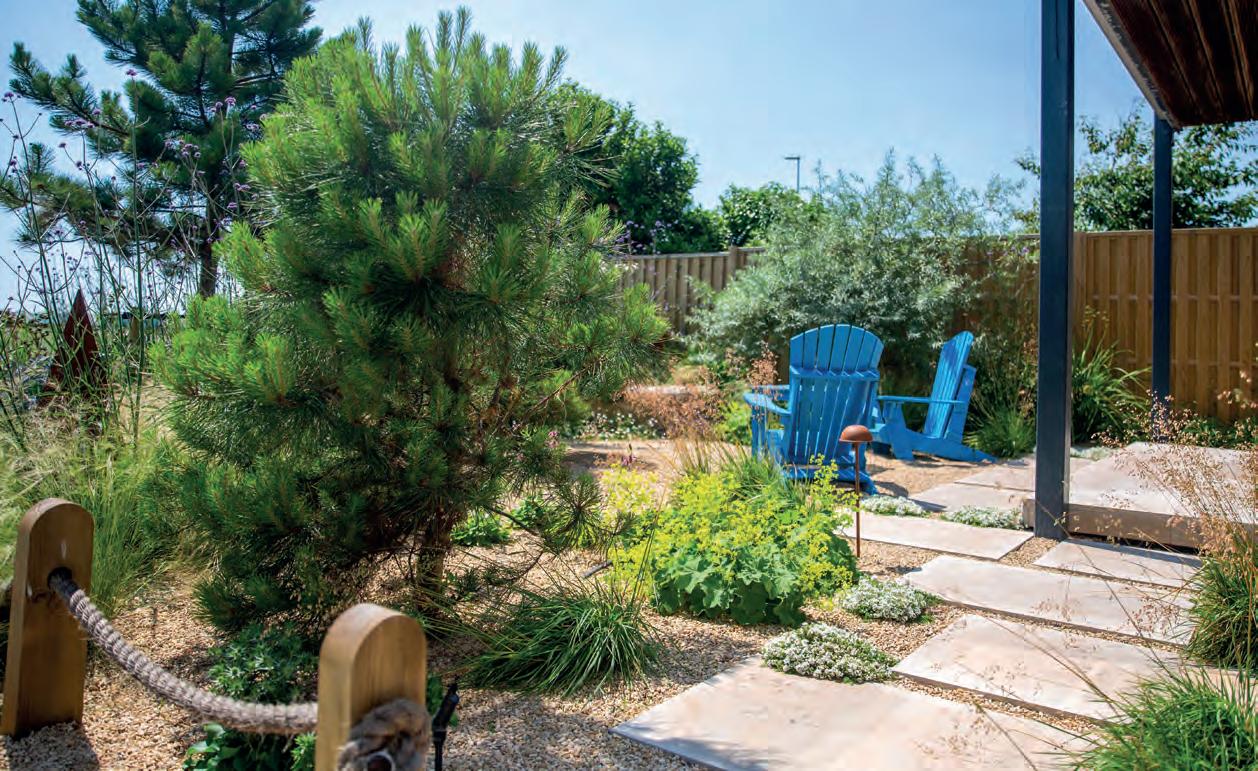


Giant Langton limestone boulders were installed using a digger arm, sitting astutely on large limestone tabs that replaced the tired grey paving and flowed seamlessly into the new Purbeck gravel.“Limestone is king here – with Jura beige slabs mixed with small-unit limestone stackers and five stunning Langton limestone boulders, all knitted together with the most wonderful Purbeck gravel,” says Goozee. Another seating area was also added, hidden away through the new planting, further enhancing the homely atmosphere in this now quieter front garden. Clumps of long-living Knautia macedonica and Verbena bonariensis add extra colour, while their sun-absorbing properties ensure durability. Hippophae rhamnoides 'sea buckthorn' was also planted on the new grass, topping off the seaside feel. Part of regaining this sunny setting in the rear garden involved using local growers and nurseries to supply perennial, sun-loving plants. Viburnum burkwoodii hedges and Elaeagnus ‘Quicksilver’ trees, used to provide privacy around the hot tub, offer


a dreamy backdrop for the new owners. Perennials including Verbena bonariensis and Nepeta racemosa ‘Walker’s Low’ further enamour them to their space. After the project was completed in October –followed by a harsh winter – the owners were delighted to see their new garden not only intact –a concern on the brisk south coast – but teeming with wildlife in the summer, giving them a place to relax, entertain, and engage with nature.
5 Eryngium ‘Big Blue’ sea holly
6 Roped-in and raised-up front garden
7 Langton natural Purbeck boulder
8 Cedar screen and shower
Photographs ©Sarah Ketelaars
Contractor Timeless Landscap es timelesslandscapes.uk.com
Paving: Jura Beige Limestone Paving London Stone londonstone.co.uk
Stone pavers: Zahra Beige Stackers Washed Sandstone All Green allgreen.uk
Boulders: Langton natural Purbeck All Green allgreen.uk
Gravel: Cotswold pebbles All Green allgreen.uk
Screens: Western Red (Grade A) Cedar P.A.R. Battens Southgate Timber southgatetimber.co.uk
Shrubs and perennials
Rachel Goozee Garden & Planting Design is a full-service garden design consultancy based in Brighton. It offers landscape design, horticultural advice and planting schemes for new and existing gardens; managing its projects from initial consultation, through the design process, construction and plant selection to final care and maintenance plans. rachelgoozee.com
The Plant Company theplantco.co.uk
Architectural Plants architecturalplants.com Garden Sage gardensage.co.uk Barcham Trees barcham.co.uk



From topsoil and tree shelters to wild ower seed and ground protection products, Green-tech is proud to support landscape professionals in creating sustainable and biodiverse choices for their projects.
• A trusted supplier to the landscaping, forestry and construction industries for more than 30 years
• More than 5,000 product lines with extensive stockholding and a robust supply chain
• Renowned for our professional advice and excellent customer care
• Nationwide, exible and next day delivery options
• A comprehensive programme of CPD and training seminars
Order
by
Urban Tree Planting and Tree Irrigation
Soils, Growing Media and Barks
Rural Tree Planting Wild ower Seed and Conservation
Ecology, Ponds and Bioengineering
Ground, Wind, Weed and Erosion Control
Grounds
Maintenance

Landscapeplus’ sales director shares how the company is continuing to evolve with an even greater emphasis on the people, passion, and purpose driving the brand forward

How does Landscapeplus actively contribute to knowledge-sharing within the industry?
I can still remember attending a meeting called “A View from the Top” with Paul Willavoys after my first FutureScape at Kempton Park in 2012. It focused on the lack of young people and the skills shortage within the industry. From that moment on, I realised the importance of our contribution.
Now, we’re by no means in a position to teach people how to lay paving or design a garden – but what we can do is help elevate professionals’ skills when it comes to specifying and installing Lighting, Irrigation, and Water Features. We do this by offering a free Design Support service, delivering nationwide Training Days, teaching at design schools, and - most importantly - ensuring our team has the best possible understanding of our product range to pass on to customers.

What role do you see the company playing in shaping best practices for the industry?
We want all our customers to have the confidence and knowledge to specify and install our systems. Whether they gain that through a training session, a site visit, a phone or video call, or the content we provide, consistency and trust are key.
There’s an incredible amount of knowledge within the team at Landscapeplus, and we do our best to ensure that every system ordered and sent out includes everything our customers need to succeed.


This year, we’re focused on taking our training sessions to the next level by working with the likes of in-lite and Aquascape to bring global experts on board. We’re excited to be hosting the first UK in-lite Academy this autumn - a fantastic opportunity for landscape professionals and a benchmark for the quality of lighting projects in the UK.
How do you approach building and maintaining long-term relationships with global brands?
The most recent addition to the Landscapeplus range is ADEZZ. While their products and reputation speak for themselves, what’s most important to us is that their culture aligns with ours.

That’s why we take our time when considering a new partnership by getting to know the people behind the brand. We have worked hard, particularly in the last few years, on our brand image and presence within the industry, and as a result, we are now being approached by global brands, including Adezz and in-lite. Our most successful partnerships are built on open communication and a shared commitment to serving the industry in the best way possible.
What has been a key milestone in Landscapeplus’ history?
This year we are celebrating our 25th birthday which is a huge milestone in my eyes. With some significant achievements already this year, including being appointed sole UK distributor for in-lite and growing the team, I think 2025 will be a year for our history books.
How has the company’s mission evolved since it was founded?
Our mission is very much the same as it was 25 years ago: to focus on the needs of professionals working within a garden. Our approach to achieving this is constantly evolving, with our ambitious team adopting new technologies and bringing fresh ideas.

important to us, we've come to realise that what truly sets Landscapeplus apart is the story behind the company: the people, the passion, and the purpose driving us every day. For our customers, our purpose and identity matter just as much as the value and quality we provide.
Where do you see the company being in five years?

Having been at Landscapeplus nearly 15 years, it’s been a privilege to watch the company adapt and grow and I am confident that we are exactly where we need to be with a fantastic team who are eager and ready to take on the next phase. While our mottos from 2011 – “best trade prices, direct to you, and great products” – are still true and
The easiest way to answer this question is to say that we’re going to be bigger and better in 2030. While I’m confident we’ll do that, what really matters is that we do it the Landscapeplus way –keeping our focus on our customers, protecting our culture, and delivering the best possible service.
Is there anything else you would like to add?
Our key focus in the next phase for Landscapeplus is getting to know our customers - not just professionally, but on a personal level. We want to connect with as many of them as possible to really understand their businesses, hear first-hand how we can support them, help them grow, and what they need to succeed. For our team, success is measured by building long-term, trust-based relationships.



Husqvarna batteries are specifically developed for demanding commercial use. Thanks to carefully selected, first-tier components the batteries deliver continuous power throughout the optimised runtime, tailored for strenuous tasks in various applications. Active cooling extends battery lifetime and uptime, while IPX4 water resistance standard makes them suitable for all-weather use. Built-in connectivity for easy connection to Husqvarna Fleet Services™. All because when on the job, continuous performance matters.
Husqvarna batteries are specifically developed for demanding commercial use. Thanks to carefully selected, first-tier components the batteries deliver continuous power throughout the optimised runtime, tailored for strenuous tasks in various applications. Active cooling extends battery lifetime and uptime, while IPX4 water resistance standard makes them suitable for all-weather use.
Built-in connectivity for easy connection to Husqvarna Fleet Services™. All
when on the job, continuous performance matters.
estled on the edge of Old Amersham, a civil parish market town in Buckinghamshire, lies St Mary’s Primary School. Originally opened in 1873 under the reign of Queen Victoria, the school celebrated its 150th anniversary back in 2023 with the commencement of its legacy biodiversity project, titled ‘For Every Living Thing’, designed to create a positive lasting legacy, not only for the pupils but the wider Amersham community over the next 150 years.

At the project’s forefront was a commitment to encourage biodiversity on the school grounds through the planting of a new fruit tree orchard, the creation of a new wildflower meadow, and, where possible, establish nature corridors to connect the school with surrounding green space, as well as educate both the students and school community on the benefits afforded by the nurturing of biodiversity.
The push to engage young hearts and minds with the natural environment doesn't end there, however, as off the back of dealing with the global pandemic, the school saw an undeniable need to create a space where students – regardless of their faith or beliefs – could go to escape the pressures of everyday life. This came in the form of a new sustainable peace garden, designed by the children for the children – with pro-bono support from landscape architecture practice, McWilliam Studio.
“My daughter loved rubbing the leaves to see which ones smelt.
I’m so pleased that you remembered this sensory aspect of the design.”


• Prunus serrula
• Molinia caerulea
• Deschampsia cespitosa
• Stipa tenuissima
• Lavandula
• Thymus vulgaris


Marooned within the wider playground, the garden site is flanked on all sides by hardscape, lying adjacent to a classroom entrance, and whilst the surrounding playground offers views to the encompassing landscape, it was key that this site delivered an inward-looking experience to create a zone of tranquillity and support self-reflection. Through their designs, students asked for colour, fragrance, stepping stones, and a level of personalisation – all of which was achieved within a limited budget and requires minimal funding to maintain.
“To say [the project] has gone beyond all my expectations is an understatement.
I cannot thank you enough, it is amazing and has transformed the landscape of the school.”

Tasked with creating an immersive, yet calming space – accessible to the students while on the playground – land was scalloped out to bring the garden onto a lower level to the rest of the playground, creating an intimate and immersive setting, enclosed with strategically positioned boulders. Steps now adjoin the northern part of the plot, and a uniform slope takes the site from higher to lower levels, allowing the site to be accessible from all sides, as well as additional seating added to create a space for both students and staff to rest.
Founder and director of McWilliam Studio, Gavin McWilliam, says the project required the “sensitive interpretation of children’s designs” to bring together an array of ideas that not only fulfilled their wishes to create a space they felt responsible for and comfortable in, but also offered a multitude of environmental and sensory benefits. One such inclusion is the bespoke stepping stones – supplied by Allgreen – engraved
1 Each class name was hand-carved into a stepping stone
2 An oasis of calm in a busy school environment
3 Soft, naturalistic planting provides scent, colour and texture
4 Vibrant bark from Prunus serrula providing rich colour
5 Stepping stones provided by Allgreen


with the names of each class to tie in the garden's connection with the school and its pupils. Founder and director of Allgreen, Harry Norman comments on the project, saying: “It’s a lovely story and a real pleasure to be able to give back to a community project that will help children for now and beyond.”
It’s a lovely story and a real pleasure to be able to give back to a community project that will help children for now and beyond
Harry Norman, founder and director, Allgreen
The original space was an underused monoculture lawn, but by giving over more space to planting and introducing a diverse planting scheme of perennials, grasses, and shrubs on different gradients, the students and staff have seen an increase in pollinators and other insects taking to the space, upping the site's biodiversity, as well as giving the students the chance to see nature up close. Due to the site’s location, the garden receives maximum sun during school hours and is often baked dry in the summer months
– meaning a droughttolerant planting palette was essential for limiting maintenance and ensuring the garden's longevity.
In the time since the project was completed, the school has seen a high volume of engagement from its students and staff – this is only expected to rise as peace garden monitors continue to maintain the space, which is also now being used as an additional outdoor teaching environment.
The project would not have been possible without donations from the landscaping and horticultural community who offered their time, workmanship and materials. The real cost of the scheme without these donations would have been nearer £30k
6 Land was scalloped out to create an intimate setting Photographs ©Alister Thorpe
McWilliam Studio is one of the country's leading garden and landscape design practices, winning over 50 national and international awards over almost 20 years in the industry. Renowned for its creativity, combining imaginative design concepts with a deep understanding of planting and materials and a passion for meticulous craftsmanship. The practice favours a creative language over a house style, returning to themes that inspires it, but always with a fresh perspective. mcwilliamstudio.com
Contractor FDL Landscaping fdl.group
Trees (donated) Deepdale Trees deepdale-trees.co.uk
Stone (donated) Allgreen allgreen.uk


Amenity Technical Sales Representative North East England and Scotland
You could represent Germinal’s amenity seed business in the region, working with clients across sports grounds, local authorities, landscapers, contractors, and distributors. Competitive salary, company car, and pension package.
Take your career to the next level with Germinal
Scan the QR code to apply
Closing date: Wednesday 20th August

This year’s RHS shows revealed key shifts in garden design – from sculptural hardscaping to sustainable water features and bold planting palettes
nother year of RHS shows has come to an end and with it, each of the three – RHS Chelsea Flower Show, RHS Hampton Court Garden Festival, and RHS Wentworth Woodhouse Flower Show – has offered insight into where the market could be heading.
Hard Landscaping as Sculpture
Large-scale stone and rock features emerged as functional standout sets amongst lush softscapes. From seating, tables and
birdbaths to the hexagonal stone columns in the British Red Cross ‘Here for Humanity’ Garden, designed by John Warland and Tom Bannister, doubling as planters to mimic traditional trough alpine displays anchoring the planting scheme and creating smoothlined zones.
stone and rock features emerged as functional standouts sets amongst lush


Then there was the ILLUSION 2050 garden – designed by Kitti Kovacs – which featured a granite seating slab, hand mined out of the earth with a chisel some 200 years ago. As we move towards a more sustainable era of design and build, hard landscaping has arguably taken a bit of the brunt, falling victim to ecological weariness, but when done thoughtfully, stone features not only endure but elevate a garden's narrative, providing permanence, grounding, and a tactile connection to the landscape’s natural heritage.
As Matt Evans describes them, water features remain a timeless element in garden design, and their repeated inclusion at RHS shows this year highlights just that – not to mention a welcome one amongst the summer heat.
From The Avanade Intelligent Garden at RHS Chelsea – designed by Tom Massey and Je Ahn, and the One Element balcony garden at RHS Hampton Court, designed by Nadine Charlton and Michael Lote, for Paul Hervey-
Brookes' RNIB Legacy Garden at RHS Wentworth, water features have come in all shapes and sizes at this year's shows.
Each one offered different functionalities and provided unique benefits to the space, some working to create a microclimate and regulate temperature and humidity in the garden, while others were used for grey water harvesting and sensory stimulation –adding movement, sound, and texture.
Whether serving a practical purpose or purely aesthetic, the versatility of water features in modern garden design was clearly on display, reinforcing their enduring value in creating gardens that are not only beautiful, but also sustainable and enriching to wildlife.
THE
It’s the inclusion of deeper pops of colour that is a noticeable addition to this year's shows
If stone structures were the popular choice among hardscapes, it was colourful planting palettes that swept through the softscapes.
While colourful schemes have been prominent in show gardens for a time, particularly as we shift towards a wilder stylistic approach, it’s the inclusion of deeper pops of colour that is a noticeable addition to

this year's shows. From the magnolias and purples of The Glasshouse Garden –designed by Jo Thompson – to the bright blues and yellows of Tom Pilgrim’s Hot Pocket garden.
The vibrant injections of colour were a welcome addition to the gardens, bringing a dynamic contrast to the naturalistic textures and looser planting forms seen throughout. Rather than sticking to the softer pastels or meadow-like blends, designers leaned into

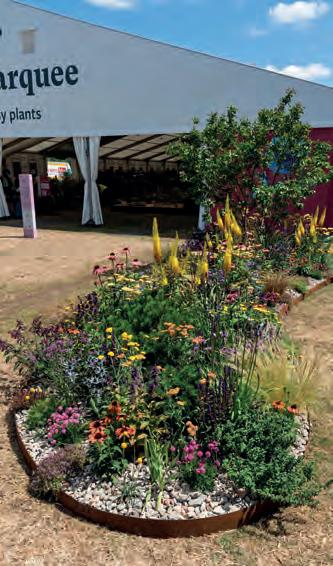
saturated tones to create focal points and emotional resonance within their spaces.
This evolving palette not only reflects a maturing confidence in colour use but also a broader shift in how we engage with planting design – embracing bolder expression while maintaining ecological intent. The result? Gardens that feel both grounded and invigorating, proving that colour, when used thoughtfully, can be as impactful as any structural feature.



Tipsy Chair
Price: £1,528
Welcoming and comfortable, the Tipsy Chair balances
Daniel Hayden’s signature characterful style with the utilitarian principles of Enzo Mari and Gerrit Rietveld.
• Simple, robust construction methods providing durability
• Made to order from sustainably sourced English oak
• Each chair has its own unique variations
• Coated in a UV-resistant oil to provide protection
• Edges rounded to give modelling clay feel themoutdoors.co.uk

Lymington Dusk
Limestone Paving
Price: £48.00 per m2
Lymington Dusk Limestone is a natural paving slab with an elegant style. Sawn flat, then distressed and tumbled, it has a textured finish that mutes the stones colour, while revealing warm swathes of red and sandy tones. Perfect for adding understated character to both classic and contemporary outdoor spaces.

• Sawn, tumbled finish with warm dusk tones and texture.
• Jura Beige look at a more accessible price.
• Ideal for pools, restorations, and indoor-outdoor transitions.
• Dense, water-resistant limestone with a smooth, durable finish.
• 900×600mm slabs in stock; custom sizes available. forestone.uk
A look at a variety of products used at the 2025 RHS Hampton Court Garden Festival


Ryecroft Cladding
Price: £126 per m2
Organic stone style
cladding which is biscuit golden-brown in tone with a distinctive coarse grain quarried in Ireland. Its face and sides are natural and rugged, with each piece hand-selected and sawn on the back so that it can be bonded to vertical surfaces, such as blockwork.
• Unique, standout shape
• Loved by traditional landscapers allgreen.uk
Featured in the 'Aster of Senses' garden


Red Reishi Dowel Spawn Kit
Price: £22
Reishi grows slowly over a year, forming striking, dark red fruiting bodies with a lacquer-like sheen. Celebrated in traditional Asian medicine for its health and longevity benefits, this unique strain was isolated in London. This kit lets you grow your own Reishi on hardwood logs at home.
• UK-Native edible mushroom species

Betula pendula
Price: Varies
Graceful native tree decorative white bark with darker cracks along the stem. The bark peels with age, with butter yellow autumn foliage. Yellow brown catkins in early spring. The open canopy gives dappled shade below. Valuable for wildlife. Effective when planted in groups of three or five. Available in multi-stem and standard options.
• Valuable winter interest tree
• Tolerant of most soils provendernurseries.co.uk

Featured in the 'Subaru Cocoon Garden'
Slow growing species adding ornamental interest to your garden
• Naturally biodegradable rapeseed wax for sealing the dowels to log
• No experience needed - comes with detailed step-by-step instructions
• Customer support available via email/ WhatsApp fatfoxmushrooms.com

Cornish Granite Boulders
Price: £120+ per tonne
First quarried in the 1830s, this stone comes from Caradon Quarry on Bodmin Moor, Cornwall. All the stone set aside has been utilized, from the hundred years the quarry operated for; the granite reclaimed directly from the moorland quarry, restoring it in the process.

• Granite from Bodmin Moor, Cornwall
• Reliable granite – used on Tower Bridge
• All of the stone used is either reclaimed or offcuts
• Many boulders feature hundreds of years of weathering
• Suitable for monoliths, water features and walling caradonstone.co.uk


David Karásek shares the inspiration behind Mmcité ’s new fully recyclable range of plastic street furniture
Since the first fully synthetic plastic, Bakelite, was invented in 1907, questions have persisted regarding sustainability and negative environmental impacts. Now, 270 times more plastic is produced per year than just 70 years ago – and only 9% of it ever made has been recycled. Street furniture manufacturer mmcité has partnered with recycling specialist Plastic Guys to create modern street furniture out of the latter’s new ‘Mínus Material’, which it says is ‘100% recyclable’. It focuses on durability and renewability in a world where over 350 million tonnes of plastic is produced every year - 77% of which goes to waste. It was this mass waste realisation that birthed the idea of Mínus. Recognising that
The world must move toward a circular future –there is simply no other option
most of its materials arrive in plastic, and rather than letting it go to waste, the Czech Republic-based company ran its own tests; concluding plastic, like metals and paper products, can be 100% recycled. “If this waste wasn’t used to produce Mínus, it would end up incinerated” says mmcité CEO, David Karásek. “The material is primarily made from production waste that is still of high quality but, due to one or more defects, cannot be sold”, this includes fishing nets, keyboards, refrigerators and televisions.
David Karásek
“For a long time, we felt that recycled material was missing in our offering, but it wasn’t easy to find a manufacturer who would stand behind the quality of recycled plastic. Afterall, the material needs to withstand all seasons and specific conditions.” He calculates that, for every one kilogram of plastic they recycle, 1.7kg of CO2 is saved by not sending it to landfill, or incineration.

As opposed to thermosets, a plastic type which cannot be reprocessed, Mínus uses thermoplastics that can be reprocessed, which allows for up to 10 recycles. “However, there’s a simple trick:
• 400m tonnes of plastic are produced each year
• This is expected to exceed one billion by 2060
• 9% of plastic is recycled
• 82m tonnes per year mismanaged or littered
• Incineration can release more CO2 per tonne than burning coal
References
• Bullet points 1, 2 & 5 – UNEP, https://www.sas.org. uk/plastic-pollution/plastic-pollution-facts-figures/
• Bullet points 3 & 4 - https://ourworldindata.org/
during the 11th recycling cycle we add 10-15% of new plastic to the mixture, and the product regains its desired strength. The world must move toward a circular future –there is simply no other option.”
The market has responded positively to the introduction of Mínus which, at present, is used across three collections in mmcité’s portfolio: Morse, Morse Dot, and Orbit. It is the ambition to apply the material to other products, but it is simply a matter of waiting for the right moment, says Karásek: “We launched the material on the market about three months ago. Already, we see it beginning to appear in various projects across different markets.” As the process of selecting street furniture usually lies with public tenders, it can arguably take longer to see results out in the open. Mmcité expects the first projects using Mínus to be unveiled next year.

SUMBISSION DEADLINE EXTENDED UNTIL 11 AUGUST 2025
Maintenance Contract | Commercial Build project under £500,000 |
Commercial Build project over £500,000 | Commercial Design project under £500,000 | Commercial Design project over £500,000 | Sustainable Product of the Year – Hard Landscaping | Sustainable Product of the Year – Soft Landscaping
Grounds Maintenance Company | Landscape Architecture Studio | Garden Design Company | Landscaping Company under £2.5m Turnover | Landscaping Company over £2.5m Turnover | Supplier or Service Provider | Local Authority/Council of the Year | Sustainability and Biodiversity Leader
DOWNLOAD THE ENTRY GUIDE


Contact Will to enter will.williams@eljays44.com | 01903 959390 Contact the team for partnership opportunities ollie.finch@eljays44.com | 01903 777579 luke.chaplin@eljays44.com | 01903 777582


Michael Norman-Kime , managing director and owner of SITEWORKS on
why it’s
time to overhaul commercial furniture installation training
At SITEWORKS, we have issued a strong and urgent call to reform the current training standards for commercial furniture installation (CFI). As a specialist company working in this field every day, we have seen firsthand how the existing training such as NVQ Level 2 is unfit for purpose when applied to our specific sector.

While existing qualifications may serve the broader construction industry, they fail to equip furniture installers with the specific technical, safety, and logistical skills required for complex commercial fit-outs. The result is a growing number of underprepared workers expected to operate in high-risk; construction environments without the training they truly need.
The current qualification is designed primarily for fitted furniture, such as kitchens, bathrooms, and bedrooms. These projects tend to involve repeatable tasks and products, for example, standardised joinery, spray painting, and similar installations. In contrast, commercial furniture installation is an entirely different discipline, requiring a vastly broader skill set.
Sadly, the construction industry is in a mental health crisis, with two suicides recorded daily across England and Wales. A modern, role-specific training programme must look to include awareness of mental health, signposting to support services such as Lighthouse Construction Industry Charity, and promoting a culture of care across the sector.
Commercial furniture installation is an entirely different discipline, requiring a vastly broader skill set
Commercial Furniture Installation (CFI) projects involve a unique combination of products from numerous manufacturers, with varying finishes and specialist integrations such as electrics, AV, glass, and air conditioning. Installers are expected not only to handle these technical variations but also to manage the complex logistics of moving thousands of components into and around active construction sites.
With increasing pressure to cut costs and accelerate programs, CFI is now often undertaken during live construction phases. This creates a dangerous skill gap, with people working in unfamiliar, high-risk environments without the necessary training or experience. Existing qualifications simply do not prepare them for this.
The absence of a recognised and dedicated training programme for CFI creates further problems. Access requirements for construction sites vary, forcing people to undergo multiple, inconsistent training courses at great cost and delay. There’s also more at stake than physical safety.
It’s time to acknowledge the limitations of current systems and take meaningful action. We believe the solution lies in the development of a nationally recognised, role-specific training and accreditation programme for commercial furniture installation. This must go beyond basic joinery. It needs to combine practical installation techniques across a diverse number of products with live-site safety protocols and hazard awareness. It must also include logistical planning, coordination with other trades, and a facility for continued professional development with support networks built in as standard. Improved training would not only protect workers and enhance project efficiency but also be a further step towards creating improved spaces for the public realm and supporting sustainability goals and delivery of long-term value for the environments we occupy. We are calling on contractors, architects, furniture dealers, manufacturers, installation companies, and industry leaders to come together and support this crucial training reform. siteworks-training.com


To support and sign the petition for the training reform, visit: change.org/p/reform-training-forcommercial-furniture-installation SIGN THE PETITION




Pinus sylvestris offers a sculptural, resilient conifer with its warm, peeling bark and airy canopy. Adaptable to varied soils and climates, it provides year-round structure, supports biodiversity, and demands minimal upkeep- ideal as a specimen or group planting in parks, streetscapes, and sustainable green projects. Contact us to learn more about available stock und possibilities!
Boom & Bonheur – because trees give life and bring happiness

















The new Biodiversity Action Plan for Queen Elizabeth Olympic Park continues to ensure the legacy landscape is a home for people and wildlife
WORDS: NINA MASON

Queen Elizabeth Olympic Park is seemingly going against the grain. While the 2023 State of Nature report has the UK in a biodiversity crisis, with a 19% species decline since 1970, the site in East London is finding new and rare species across its 102 hectares –and that’s despite hosting 20 million visits each year.
A recent intensive biological survey with specialists from the London Natural History Society


found three new species of bee – coastal leafcutter, sickle-jawed blood bee and large sharp tailed bee –bringing the total number of bee species recorded on the site to 76. The ringlet butterfly became the 23rd species of butterfly to be spotted too, on top of 42 species of bird being recorded that day and 23 species of lichen. A new species of hyper-parasitic wasp, Hedychrum rutilans, was also discovered.
The findings were revealed in the Park’s latest Biodiversity Action Plan (BAP), which it updates every five years. “There was plenty of biodiversity present before development; it wasn’t devoid of life, by any stretch. But it’s impressive that we’ve been able to retain a lot of our priority species,” says the Park’s on-site ecologist, Tom Bellamy, who has been seconded to grounds maintenance provider idverde from the RSPB and who put together the latest BAP.
“Brownfield specialist species like the brown banded carder bee were already present and we managed to help this population

develop, and the variety of planting that’s been put in has attracted lots of different invertebrate species. So, the diversity might have improved, but it has been built upon a solid foundation.”
He now wants to use the data collected through surveys and submissions to inform the Park’s management decisions. “So, rather than going out and managing an area without fully knowing what you’ve got in there, you react to the data; it’s basically treating each of the habitats individually, so each will get a slightly different approach based on the species we find there.”
A “quality over quantity” approach to biodiversity is being adopted.
“The Park is still undergoing development, so we’re replacing some green space with homes as set out in the legacy plan. So, the spaces we have, we make sure it is in as good a quality as possible,” says Bellamy.

was largely known for housing a large pile of discarded white goods. Its contaminated soils and polluted waterways were then transformed into venues for the global sporting event and a luscious parkland that would be the Games’ legacy. Its transformation is ongoing too, turning the Park into both a visitor attraction as well as a home for local residents and businesses.
A series of developments have brought a new local community to the area, from East Village – which was once the Athletes' Village and is now a thriving neighbourhood with over 2,800 homes and more planned –to the contemporary neighbourhood of Chobham Manor.
The Park has been designed with areas where people are less likely to go and where wildlife can thrive
“There’s definitely a pressure on the Park because of the amount of people, and we find that the most biodiverse areas are where wildlife would have a bit of respite, so in less accessible areas. In high footfall areas, we find less wildlife because of disturbance and habitat degradation, which is normally seen during events when there are a lot of people concentrated in one area. But the Park has been designed with areas where people are less likely to go and where wildlife can thrive.”
Thomas Bellamy, on-site ecologist
Then there’s East Bank, the new education and cultural quarter, featuring BBC Music Studios, V&A East, UAL’s London College of Fashion and University College London (UCL), and a 550-seat theatre and hip-hop academy that form Sadler’s Wells East.

landscape and public realm at the London Legacy Development Corporation, the organisation behind the Park. “Seeing the London College of Fashion students outside, enjoying the spaces and occupying the terraces and doing fashion shoots, for instance, is great.”
Next to the UCL and towards the south of the Park is Riverside East, a cafe and entertainment space with a rooftop terrace that features a wildflower garden on what was an extensive green roof. It sits under the towering red tunnel slide, ArcelorMittal Orbit, and alongside the London Stadium, becoming a West Ham fan zone on match days.
Prior to the Olympic and Paralympic Games in 2012, the sprawling brownfield site
“The occupation of the buildings has completely changed how people perceive the park and has brought in different audiences,” says Ruth Lin Wong Holmes, head of


Four new schools opening has brought more children into the park as well. “The playgrounds are swarming with kids, and we opened up another bridge to Gainsborough School in Hackney so that they now have better access to the canal path. We’re dealing with extra visitor numbers and worn paths, as any Park has to – but it’s really good to see.”
Creating inclusive communities and environments is central to LLDC’s approach. Earlier this year, it published an update to its Inclusive Design Standards, which included a focus around neurodivergence and trying to ensure there are more sensory-focused spaces.
“We’ve been able to incorporate that more and make sure our design teams have an understanding of it. For example, lived experience feedback has highlighted that brightly coloured road crossings can be overwhelming if you’re neurodivergent, which links to the UCL PEARL – Person-EnvironmentActivity Research Laboratory – research shows that patterns and colours in nature don’t create the same sensory overload as more rigid patterns do.”
One of the most impactful changes to come from reviewing the standards, though, is setting up a Women’s Safety Board.
The LLDC commissioned Arup to carry out research into the perceived safety of Queen Elizabeth Olympic Park for women and recommendations for improving this. That fed into further guidance, says Holmes. “That was strategically led from our board members all the way through to our senior management to those writing the policy and delivering it. So, there was a really good feedback loop between people working day to day on the Park and policy making.”

access to high-quality green space, and there’s social value in what we’re doing.”
A collaborative approach has been at the heart of the LLDC’s strategy from the start, and it continues to consider how the community can be part of that. For new neighbourhoods, for instance, making new residents feel welcome and included is paramount. Still to come are the two phases of Sweetwater which, together with East Wick – for which the first of four phases has been completed –will create a new neighbourhood to the northwest of the Park. Then there's Pudding Mill and Bridgewater Triangle –another one of the five neighbourhoods in total – which are going through planning.
The occupation of the buildings has completely changed how people perceive the park and has brought in different audiences
And planners for the new developments will, of course, work with Bellamy to ensure they align with the latest BAP. The overall goal of the plan is to achieve good ecological status in all four of the Park’s habitat sites – wetlands, woodlands, grasslands and urban – and to achieve a stable breeding population for its 33 priority species amongst others, says Bellamy. “Our move to evidence-based management is going to be key because we’ll be able to tailor our management specifically to what each habitat is requiring, and it will give us more flexibility.
Ruth Lin Wong Holmes, head of landscape and public realm, London Legacy Development Corporation
LLDC is now moving into its next phase, which will focus on the activation and optimisation of assets, alongside the completion of the development of new homes and neighbourhoods, to drive inclusive growth in East London, ensuring subsequent benefits are felt by the local community and more widely across the capital and the UK.
“That’s the next phase, and making sure that we’re connecting communities and ultimately changing the lives of East Londoners. The Park has transformed people’s
“All the areas need to be managed; we can’t just let things be.
A lot of our habitats, like scrubland, are transitional habitats and so, if left without management, would eventually head into woodland – which is a fantastic habitat, but we need to manage certain habitats to maximise their biodiversity offering and keep them in that state.”
Above all, the new BAP allows the Park to be adaptable to changing needs and demands, as it continues in its evolution of what has undoubtedly become one of the pinnacles of a legacy landscape.
















A rising need for drought-tolerant planting has seen an uptake in xeriscaping in the UK, but what else does this low-maintenance style have to offer?
WORDS: BEVERLEY D’SILVA
Water conservation is making the world headlines, with factors from an overheating planet and water waste to war and conflict at the root cause. The need to save water, a precious resource, affects every country, and the UK is no exception.
Though we generally have a cool, mild climate here, which is likely to change, according to the Met Office, with the prediction of hotter and drier summers and warmer and wetter winters to come.
Thankfully, the UK is far from forgoing the lush landscapes and green and pleasant gardens it’s famous for, but there is a water-saving and innovative landscaping approach that is proving ever more popular here: xeriscaping.
So, what is xeriscaping? In a nutshell, it is a way of creating a beautiful, eco-friendly outdoor space while minimising the use of water. This easy, low-maintenance gardening style puts drought-tolerant planting centre stage.
Besides water conservation, xeriscaping can save on water bills. It’s estimated it can cut water use by half to three-quarters (50-75%). That’s not


forgetting saves on time and effort, as not having to water plants and weeds as frequently, or maintain lawns, can ease the gardening load.
Xeriscaping, which comes from the Greek word ‘xeros’, meaning dry, is also known as water-conserving landscaping, drought-tolerant landscaping and smart-scaping. The term was coined in the early 1980s, in Denver, Colorado, says Noelle Johnson, Arizona-based horticulturist and author of Dry Climate Gardening, when drought conditions encouraged people to decrease water use around their homes. Awareness and use of it have been building since.
We don't have an endless supply of water, so it's really important to look at how we use it
Asa
Gregers Warg, head gardener, Beth Chatto’s Plants & Gardens
At Beth Chatto’s Plants & Gardens, a renowned ‘dry’ garden in Essex, the term xeriscaping is not in common use, but its water-saving principles are, according to head gardener Asa Gregers Warg: “Much of what we do is about water conservation – that's the whole point of the gravel garden for example,” she says, referring to one of its most popular gardens.
Today, Beth Chatto’s Gardens are held up as a model of sustainable, drought-tolerant planting. But when its eponymous creator, the late English garden designer, began developing its 7.5 acres in the 1960s, it was a wasteland. In large parts of it the soil was too dry - “we’re on a par with Malta when it comes to rainfall,” says Warg – too wet in others. Chatto began by selecting drought-tolerant plants, like santolina


chamaecyparissus, lavender, cistus, stachys and Ballota pseudodictamnus, which thrive in hot, dry Mediterranean climes, for the dry areas. She pioneered the ‘right plant, right place’ idea and wrote The Dry Garden (1978), among other books on the subject.
As head gardener there since 2001, Warg has witnessed xeriscaping becoming more relevant in the UK: “Especially with a changing climate and the long hot summers we had in 2021 and 2022, with little rain for long periods. We don't have an endless supply of water, so it's really important to look at how we use it.”
Overwatering plants and gardens is a common mistake. “But if you select the right plants for the growing conditions, you can reduce watering a lot,” she says.
If you select the right plants for the growing conditions, you can reduce watering a lot
Asa Gregers Warg, head gardener, Beth Chatto’s Plants & Gardens
So, how best to approach xeriscaping? A thriving, sustainable xeriscape garden is based on certain techniques, including selecting plants with low water requirements and mulching them to reduce water loss and making landscape choices that call for less fertilisers and chemicals in order to thrive. It can also mean replacing thirsty lawns with rocks, mulch and drought-tolerant plants.

Ornamental grasses, which lend structure and colour to a xeriscape, and succulents and cacti, which are champions of water retention, are all plants that will do well in the UK too. Ground cover plants such as sedum, creeping phlox and creeping thyme can help conserve soil moisture and suppress weed growth. And deep-rooted perennials, like lavender, yarrow, and thyme dig deep for water, which reduces your need to water them.
Things to consider when creating a xeriscape garden
Design and planning – A good starting point is to think about your soil type, sun exposure, and water availability. Plant choice – Think right plants for the right place. Succulents and wildflowers are great choices that need minimal watering and maintenance. “Look for small-leaved plants, silvery foliage that attracts the sun, succulent foliage, and hairy leaves that trap moisture,” is Warg’s tip.
Irrigation and watering –
Water saving can be achieved by installing efficient irrigation systems, like drip irrigation. Collecting rainwater in a water butt is another way of conserving water.
Soil – A successful xeriscape rests on healthy soil. Test your soil’s texture and pH (use a test kit or ask a pro to do it) to check if it’s too full of clay or too sandy. To sandy soils, add organic matter like compost, peat moss or manure to increase water retention. Heavy clay soils can be broken up with sand or fine gravel mixed with organic matter (such as above).
Mulching – Applying mulch like bark chips, grass clippings or manure to the topsoil can help retain soil moisture, suppress weeds and regulate soil temperature.
Drainage – Make sure plants are placed in free-draining soil to avoid them becoming waterlogged. Enhance drainage with materials like sand or fine gravel mixed with organic matter.
Irrigation – In a system where water conserving is king; it’s less about the right amount and more about the right timing. Watering in the early hours is good as it reduces evaporation, and plants have time to drink before the heat descends. And like children, keeping to a routine is helpful for them too.
Ongoing maintenance –
While this method reduces constant watering, mowing and fertilising, some weeding and pruning will help keep your xeriscape looking glorious. Then it’s seasonal check-ins: possibly a light layer of compost in the spring; watching plants aren’t waterstressed in summer; reducing any watering in the autumn, however. So, it’s key not to focus solely on drought-tolerant plants, which will struggle or die next time we have a wet summer, which would risk leaving your garden sorely depleted.
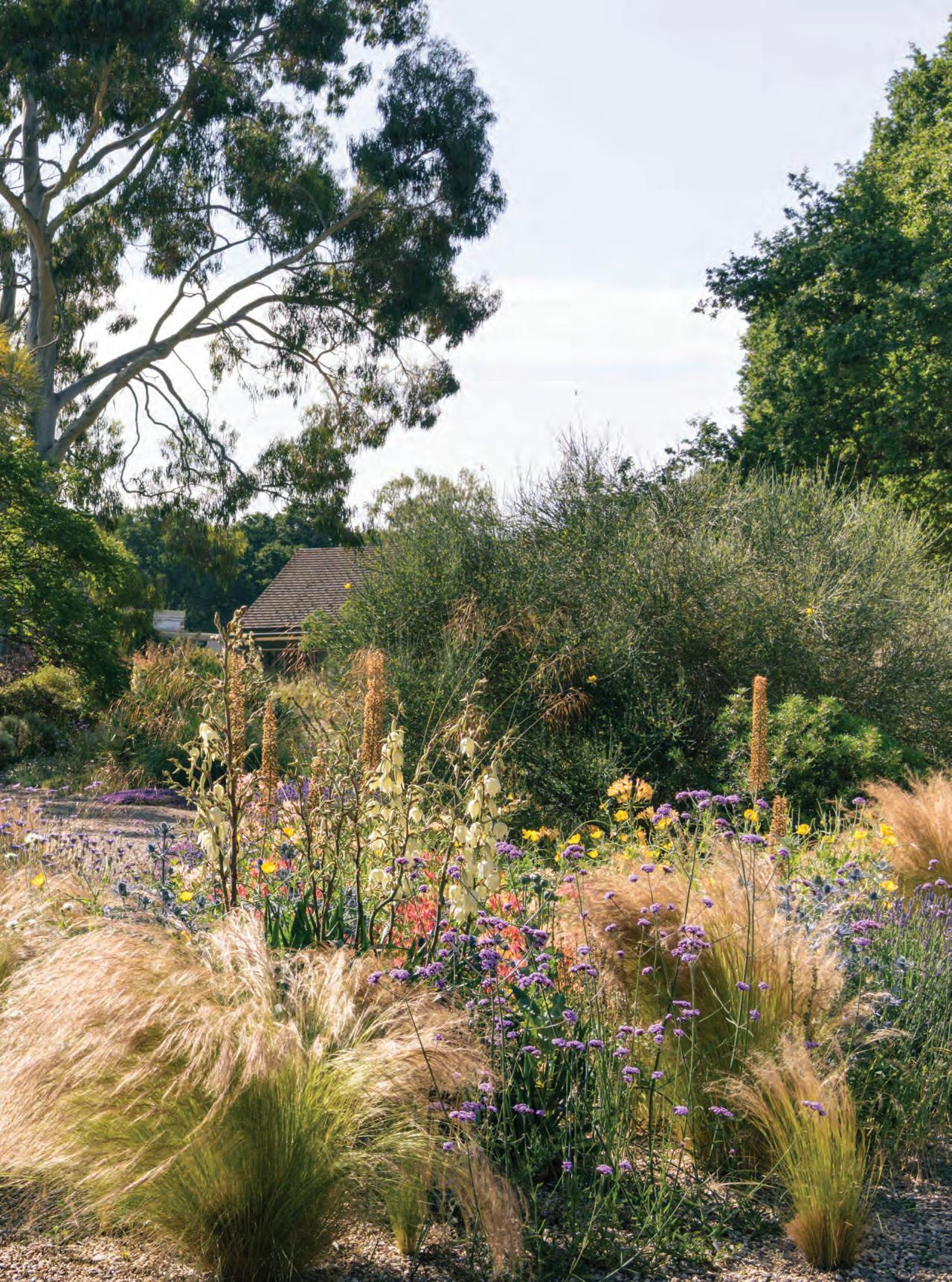
What about periods of heavy rain, such as last summer in the UK, when some regions had twice the normal level of rainfall? Michael Perry, known as the Green Geek on Instagram, says that it shouldn't be such a big deal.‘These types of plants benefit when they have more water,’ he says.‘They're going to grow quicker and be slightly bigger. But they will also be able to withstand drought conditions.’
This method wouldn’t be the best choice for areas of consistently high rainfall, however: “Beth would never have created a gravel garden if she had been in Wales, for example,” says Warg. So, knowing your landscape’s conditions and soil is key. “It doesn’t make sense to bring in tonnes of gravel if you’ve got perfectly fine compost. But if, say, you’re facing increasingly wet winters, you can work with it by improving the drainage for example.”

While this approach can be a win-win going forward, taking into account your growing conditions and knowing the difference between drought-tolerant and droughtresistant plants is important. Drought-resistant plants will survive extremely dry conditions for a prolonged period of time; droughttolerant plants can survive unusual periods of drought but need a little more water than drought-resistant ones.
Even with the latter, in very hot dry summers with no rain, some will shrivel up and show signs of stress,“but they can come back as soon as temperatures drop and have a bit more rain,” says Warg.“Just don't expect the garden to look the same throughout the whole year.”
Similarly, a xeriscape by nature will be a different animal to the traditional English country garden: “You can't expect the same lushness and abundance of colour in high summer, especially if there's a drought,” says Warg. She refers to Mediterranean gardening: “There, you find a much more bleached-out colour palette, and it's the same thing here. So, to add interest, you need to consider different textures and forms and shapes.”
“Xeriscaping is only for dry climates, not cooler regions like the UK”
As we’ve seen, going forward the UK is likely to experience hotter drier summers, so this method is going to become more appropriate here as we seek ways to reduce irrigation and focus on resilient planting. Working with nature rather than fighting against it.
“Xeriscaping is like ‘zero-scape’, or no plants”
Just because you’re removing heavy water consumers like lawns and thirsty plants, your xeriscape should not look like a featureless wasteland - far from it. “As you add more plants, you create a microclimate. This helps the plants, especially if it’s very hot and dry. With plants that are fairly close together, they create shade for each other too - helping each other and boosting biodiversity and insect population.
“Choose only droughtresistant plants over native ones”
Native plants are important for supporting local wildlife and biodiverse ecosystems, as they attract pollinators like bees, butterflies, and other insects. They are acclimatised to the local climate, soil and pests, so they are more likely to thrive with less fuss. “There are many native plants that are drought-resistant too,” says Warg, naming sea holly, sea kale, thrift, gorse, broom and rosa spinossisma. “So, you don’t have to exclude one or the other.”
The Beth Chatto team recently completed a public space in Colchester; “We basically took crushed bricks and rubble from a building site next door, and created mounds, then put drought-resistant planting in,” says Warg. The scheme was a big hit locally, which just shows you can work with any medium - providing you select the “right plants, in the right place.”
You can't expect the same lushness and abundance of colour in high summer, especially if there's a drought
Asa Gregers Warg, head gardener, Beth Chatto’s Plants & Gardens

How do we square the demand for extensive paved outdoor living spaces with increasing rainfall? Angus Crichton, ACO’s House and Garden marketing manager explores how aesthetic surface drainage solutions provide the answer.

Award winning gardens often feature extensive paved areas for outdoor living. Take the 2024 Pro Landscaper Project Awards.
The £50,000 Hard Landscaping award went to D&S Precision Landscaping for its Little Mead project, in which the client moves across elegant paving from their house to a new outbuilding via an outdoor kitchen and seating around the firepit. Around half of the domestic projects showcased in Pro Landscaper’s The Collection 2024 feature similarly extensive paved areas. During the coronavirus pandemic, those of us fortunate to have gardens suddenly found
they were one of the few outdoor spaces we could access. This has fuelled the trend of gardens replicating interior living spaces for cooking, dining and relaxing.
A grating can be specified either almost to disappear or to stand out as a design feature in its own right
The domestic home design and remodelling platform Houzz reported searches for “outdoor kitchen” went up by a third in 2024 in comparison to the previous year.1 Outdoor living is often built upon paving, yet in the same period we have seen some of the wettest weather on record.
Raining on my paving parade

The weather was so bad through Winter 2023 that D&S Precision Landscaping had to erect temporary shelters on the Little Mead site to progress the work. The Met Office 2023/24 storm season timeline gives a roll call of storm names over this period: in the midst of Henk, it is hard to recall Ciarán. Where I live in Oxford, a month’s rain fell in two days during September 2024.

When all that water falls on extensive paving, drainage provision is essential — unless the paving is permeable. In this publication, Gareth Wilson, an award-winning garden landscaper of over 30 years, has already warned about inadequate drainage. Water running off a patio into the lawn “can cause a boggy mess in no time at all, especially with the volume of rain we have been having.”2
This begs the question of how to meet the consumer demand for elegant, extensive paved areas for outside living while accounting for increasing rainfall. The answer is aesthetic and effective surface water drainage.
Aesthetic and effective surface drainage solutions
Based on London Stone’s blog, a client will see little change out of £15,000 ex VAT to lay a 40m2 top-of-the-range porcelain patio.3 When a client makes this magnitude of investment, they do not want a utility drainage channel slicing through their fine porcelain finish.
There are options beyond a standard plastic or galvanised steel channel grating. A grating can be specified either to almost disappear or to stand out as a design feature in its own right. The 10mm inlet of ACO’s Brickslot gratings connects via an upstand to the channel beneath, allowing the channel to be paved over, rendering it invisible. However, as the channel is now inaccessible, access covers must be fitted at regular intervals in long runs and after every change in direction to allow maintenance.
Aesthetic gratings complement high-end paving, enabling surface water drainage
ACO’s Brickslot gratings are available in plastic, galvanised and stainless steel, with the last offering improved performance and a distinct, high-end finish.
A variation is ACO’s Self-Design stainless steel grating, consisting of a tile insert tray flanked by two, eight millimetre inlet slots. A section of the paving material is cut and dropped into the insert tray so that the grating blends in with the surrounding paving. Two different depths of insert tray are available, to accommodate paving up to 20 or 30mm in thickness. This option does not require the installation of access covers as the grating can still be lifted to clean the channel beneath.
Alternatively, ACO has created gratings that are design statements in themselves. The sleek and elegant horizontal design lines of ACO’s Wedge Wire gratings give a more contemporary feel, available in galvanised or stainless steel. Other ACO gratings take a more playful approach, such as the eye-catching organic feel of the Voronoi grating and the weave-like texture of the Mosaic grating. These gratings together form ACO’s Complete the Look range, which complements rather than detracts from a client’s high-end paving.

Channels to match aesthetics with performance
Complete the Look gratings fit onto either ACO’s black plastic HexDrain or polymer concrete RainDrain channels. These channels will drain up to 150m2 of paved surface in most domestic installations.4 Unlike ACO’s core range of channel drains, the channel and grating are ordered separately with Complete the Look.

DISAPPEAR: ACO SELF-DESIGN
When selecting a Complete the Look grating to go with an ACO channel, the load class of both must match their use. So while an ACO RainDrain® channel is certified for vehicle use (B 125), if used with pedestrianrated grating (A 15), it will give an installation only suitable for pedestrian use. A walk down a residential street reveals buckled and broken A 15 galvanised gratings at the end of driveways that have not stood the weight of increasingly heavy domestic cars.
Project awards and portfolios demonstrate a desire for outdoor living, and with it extensive, elegant paved surfaces. However, with increased rainfall, these paved surfaces require effective drainage solutions to prevent waterlogged gardens or even flooding. Aesthetic gratings complement high-end paving, enabling surface water drainage to almost disappear or stand out as a design statement against paving.
To explore ACO’s range of elegant gratings to deliver an aesthetic surface finish alongside effective drainage, visit aco.co.uk/complete-the-look
References
1 2024 Houzz UK Emerging Summer Trends Report, 25 June 2024, https://www.houzz.co.uk/ magazine/2024-houzz-uk-emerging-summertrends-report-stsetivw-vs~176408546
2 Gareth Wilson, ‘Drain Off’, Pro Landscaper May 2024, p.22, https://issuu.com/eljays44/ docs/may_2024.
3 https://www.londonstone.co.uk/blog/how-muchto-lay-porcelain-patio-faqs/
4 A 10m run could drain up to 150m² paved area during a 50mm per hour rainfall event (in accordance with the guidance in Building Regulations for England 2015 Section H3 2.4).
Note Self-Design gratings reduce the channel’s hydraulic capacity.

A decade after its creation, Canary Wharf’s rooftop garden continues to grow, engaging communities and promoting biodiversity in the heart of London
WORDS: ELLIOT ARMSTRONG
In 1802 the West India Docks opened in Blackwall, East London, a success followed by the East India Docks just one year after: flagship architecture that gave rise to London trade, and early plant dealings from collectors on said docks initiating the influx of exotic plants now common in plots across the country like the Royal Botanical Garden, Kew. After the docks were closed to commercial trade traffic in 1980, the site later became the Canary Wharf development.
In 2015, this heritage became the inspiration behind the Crossrail Place Roof Garden project that would see the utilitarian infrastructure transformed into a green urban sanctuary, connecting the two neighbourhoods and creating an accessible public space, with landscape architecture practice Gillespies at the helm, supported by specialist planting consultants Growth Industry, and in collaboration with Foster + Partners.
Planting considerations
In the 10 years since,“the garden has grown dramatically,” shares Canary Wharf Group landscape manager, Paul Griffiths – and has gone on to have a “huge impact” on the local community, as well as playing host to several planting experiments as Griffiths explains.
We have experimented with some tender planting, such as strelitzia reginae, all of which have done well
Paul
Griffiths, Canary Wharf landscape manager
“We have experimented with some tender planting, such as strelitzia reginae, all of which have done well.” Other species however, like some bamboo variants originally planted were too invasive and had to be removed for the safety of the remaining plants; replaced with “more tropical-looking plants like musa basjoo and canna.”
Due to the elevated and enclosed nature of the garden, Griffiths shares that the main challenges lie in the site's drainage and irrigation.“The soil is only one metre deep, therefore there is no water table as such. Most of the water the plants receive is via our automated



irrigation system; this has to be monitored and adjusted throughout the year – too little water and the plants will die, too much water and the roof garden's drainage system won't be able to cope and there is potential for the retail units beneath the roof garden to flood.” The garden is continually maintained by a dedicated gardener three times a week to ensure the site continues to thrive and remains safe to the public and below units.
During the planning stage in 2015, public consultations were held to encourage a greater sense of community ownership; schools in the area were also invited to share in the design’s history and were offered space in the garden to be used for curricular activities. A decade later, the space continues to play host to community events; “at the east end of the garden is an amphitheatre which is used by schools daily, as well as by community groups and our in-house events team who put on free music, theatre and arts events for our residents, visitors and office workers to enjoy. Our office worker population use it to sit, have a sandwich and relax – we even have a community group using a space as an allotment!”


The Crossrail Place Roof Garden continues to be popular as a major instigator in helping turn the urbanised area of Canary Wharf into a bustling green space – unrecognisable from 25 years ago at the start of the millennium.

Such was the positive reception to the garden, Canary Wharf Group again turned to Gillespies in 2021 for the ‘Canary Wharf Greening Phase One’ project, which aims to increase biodiversity across the whole estate and create healthier, more vibrant environments in partnership with the Eden Project.
As part of the Eden Project, the Middle Dock has also recently been reimagined as the ‘Eden Dock’; a project –spearheaded by HTA Design – that sees spaces given back over to nature with new and diverse habitats established, creating a vibrant waterside oasis for people to come and connect with nature in the heart of London.
Where green infrastructure in urban environments was once seen as a nicety – a luxury, even – it is now viewed as crucial for healthy living – physically and mentally. Continued urban density and an increased awareness of climate change, as well as greater societal consciousness on health, has led to these changes.
The soil is only one metre deep, therefore there is no water table as such. Most of the water the plants receive is via our automated irrigation system
Paul Griffiths, Canary Wharf landscape manager
The covid-19 pandemic only highlighted this, reinforcing the need for natural spaces, and the continued improvement in cities reflects these needs. In June, the mayor of London, Sadiq Khan, launched a new Green Roots Fund, investing more than £12m to make neighbourhoods greener, indicating a continued shift towards lusher and greener cities.


Walworth Community Garden is important for biodiversity, accessibility and a sense of togetherness, while growing plants with the planet at the forefront using hands from all backgrounds



As the planet warms, it has become more important than ever to care for wildlife, plants and people. The recognition of climate-resilient plants has been a growing concern in recent years. But is it possible for the horticultural industry to deliver both beautiful and sustainable landscape spaces, while also prioritising accessibility and inclusion?
Founded in 1987, Walworth Garden offers a green refuge in busy South London for a thriving community that continues to grow. It is home to a well-established charity, a garden shop, gardening therapy sessions, a variety of horticultural courses, and a wide range of environmental, domestic, commercial and community landscaping services.
Led by head gardener Oli Haden – who champions diversity and accessibility within horticulture –Walworth Garden is the only community garden accredited by the British Association of Landscape Industries (BALI). Not only is its demonstration garden open seven days a week, 365 days a year, but Haden is also actively developing sustainable landscape designs for clients and the wider public.
According to the Met Office's annual State of the UK Climate report, record-breaking temperature and rainfall extremes are becoming the 'new normal'. The data shows the UK has been warming by approximately 0.25°C per decade since the 1980s.
Many plants can adapt to these shifting conditions, and Haden sees an opportunity for gardeners to support natural resilience rather than over-manage. "It's important to recognise the resilience of living things and how they adapt to their surroundings if you give them a chance," he says. Although this hands-off approach may feel unconventional, Haden argues that in the long run, it's better for our landscapes.
We need to expand our understanding of what makes a garden beautiful and think beyond traditional aesthetics
"We need to expand our understanding of what makes a garden beautiful, and think beyond traditional aesthetics to grow spaces that also serve the environment and wildlife," he adds. Much of that work is about experimentation with planting and monitoring habitat growth. "Our rubble garden," explains Haden, "is where we have deliberately changed the very foundations of what we think of as a planted landscape, to experiment with its possibilities".
Living organically: A sustainable garden
Operating on organic principles, Walworth Garden puts the planet first. Haden believes that plants have a better chance of thriving – especially in the face of climate instability – when left to grow naturally with minimal human interference.

In this demonstration space, household building materials that would otherwise be discarded have been reused. Evening primrose, verbascum, solidago and grasses, grow happily through brick, concrete and paving slabs –abuzz with insect life. This shift in the aesthetic, as Haden describes it, "can make a real difference in both reducing our industry’s waste and becoming better stewards for biodiversity."
Another example where Haden has let nature run its course is through the growth of a self-seeding tree, whose roots have headed straight toward the garden's wildlife pond. While the pond sits in several layers of redundant carpet and a butyl liner, this particular tree has sensed the water and grown over the top of these layers, before splaying its root system within the water. Haden calls it a "fascinating phenomenon" –a powerful example of nature's ability to adapt. These kinds of self-driven outcomes, he believes, should be encouraged by the industry, with a patient embrace of nature.
That said, embracing this philosophy often requires breaking away from long-held norms. Avoiding pesticides, limiting fertiliser use, and reusing aggregates may seem unconventional – but these choices can pave the way for even more innovative thinking.
Much like broader society, the horticultural world is beginning to question long-standing norms. One organisation leading that change is
@decolonisethegarden on Instagram. A decolonised garden, it argues, is "one in which we dismantle and compost our oppressive, supremacist systems" – a shift in both practice and mindset. In alignment with this ethos, Haden adds: “In many ways, gardening in the UK is intertwined with British culture, and with that often comes the rigidity of the traditional English landscape garden, which is deeply embedded with colonial values.” He explains that disrupting this aesthetic approach is just one small part of a broader system change. On a practical level, this includes encouraging domestic and commercial landscaping clients to incorporate techniques that they might not be used to, like the rubble garden or recycling aggregates to fill habitat-forming gabions.
Not only is this helping the planet, but a shift in perspective could be exactly what the horticultural industry needs, claims Haden, alongside those parts of @decolonisethegarden. Haden says: "In horticulture, we are behind other industries where that disruption has been going on for some time."
According to the 2024 Equality, Diversity and Inclusion survey by the Charter for the Horticulture, Arboriculture, Landscaping and Garden Media profession, the majority of industry professionals – based on over 650 respondents – are British (85%), aged 45–54 (36%), and heterosexual (81%).
Walworth Garden, by contrast, is working to widen access. As its website states, it "serves the community that built it." Haden elaborates: "We work to support those historically excluded from our industry. In London, this particularly includes those from low-income backgrounds and individuals from black, asian, and minoritised ethnic groups, who face systemic barriers to accessing green spaces. We stand in this little area to remedy that."
We work to support those historically excluded from our industry... We stand in this little area to remedy that
Oli Haden, head gardener
The "disruption" refers to the shift in aesthetic while fighting for the planet, but also for the people working within horticulture. This means including underrepresented and diverse groups, which is something else Haden and the team at Walworth Garden are passionate about.
This mission is put into action through its horticultural training centre, which offers Level 1 and 2 courses accredited by City & Guilds. The new Level 1 course enables new gardeners to learn base level skills before heading into Level 2, a course that might be slightly overwhelming for a beginner. The introduction of this beginner-level course "makes it more accessible," says Haden. By enabling an accessible path for historically excluded groups, Haden and the team are breaking down these systemic barriers. He clarifies: "That's why securing funding

Oli Haden’s tips in creating a sustainable garden for yourself, or a client
1 Step away from the aesthetic
2 Encourage re-using and recycling through rubble gardens or gabions
3 Plant during the wet months so the root system can thrive before the hotter, dry months
4 Question the need for additional resources e.g. raised beds
5 Incorporate wildlife ponds for a productive use of water and ensuring accessible pathways is essential to fostering a diverse community within the industry."
From providing a welcoming space for all –“that’s something community gardens can do for people,” explains Haden – the value of these spaces goes far beyond accessibility. They also encourage the increasing need of all hands to protect the planet for years to come as the industry tries to break down barriers, from wasteful aesthetic limitations to diversity and inclusion.







Alan Sargent explains why establishing expertise and understanding the legal framework is essential before commissioning a professional report
Commissioning an expert witness to produce reports and investigate disputes in cases of complaint involving landscaped projects, both in the commercial and domestic fields, should be undertaken only once you have established the expertise of the particular consultant. Their work is not akin to mediation or arbitration, which requires mutual acceptance and agreement on the two parties to accept the findings of the mediating consultant. Indeed, they are separate disciplines, with each holding different accreditations and proven abilities;
one to offer mediation, the other to provide independent assessments without reference to any previous chain of events leading up the dispute – or involvement in such previous matters.
Mediators and arbitrators are engaged to seek amicable agreements, to hopefully satisfy both Parties without recourse to Court claims
Although both disciplines require the same skill set when it comes to understanding construction techniques, materials and their uses, and possess a strong knowledge of British Standards and Industry Best Practices, expert witnesses are not advocates, nor do they work for the commissioning parties. They are engaged to act as the eyes and ears of the court and are usually instructed by a solicitor or by a judge to act as such.
Mediators and arbitrators are engaged to seek amicable agreements to hopefully satisfy both parties without recourse to court claims. Some judges insist that mediation is sought before allowing a case to proceed, although costs often render this low-key solution unacceptable to one or both parties.
There are two distinct types of report that are usually commissioned – Statement of Opinion and Civil Procedure Rules Part 35 reports; (known as a CPR Pt 35) both of which require strict adherence to written protocol and do not allow for deviation or empathy. All findings are those that are required by the instructing party, and may be altered, amended or added to by the expert before signing the commission if the expert deems a wider set of options is required to produce a fair report. This set of instructions is known as ‘The Brief’. Normally, the Brief will include
a collection of documents, including plans, specifications, a copy of any quotation and working method statements (known as The Bundle) and a list of questions to be answered by the expert, based solely on his or her observations made on the day of the inspection (known as an Extant report). Using British Standards/ Industry Best Practice as their guide, the expert will compare the ‘Promised’ (whatever the quotation stated) and the ‘Delivered’ (the works as viewed during the site inspection).
Having agreed on the brief and fee structure (usually paid in full, in advance to avoid any question of bias or monetary obligation) a date is set for the site inspection. It is common practice for the expert to insist that neither Party is on site, and if the owner wishes to provide access to the site, they are required to leave the expert to their own devices, working solely on the brief and pre-written list of questions produced by the commissioning Party/ Parties provided by the instruction. The expert does not take instruction from any Party during the site visit.
There are two types of report under either Statement of Opinion or CRP Part 35. One is called a Single Expert Witness report, where only one Party has instigated and paid for the report, and a Single Joint Expert Witness report, where both Parties have made equal payments to the consultant. In any event, the expert remains 100% independent, working solely as the eyes and ears of the Court, and not for either commissioning Party.
The spectrum and range of commissions is as wide as there are disciplines within the landscape industry. I deal with around fifty commissions each year, and whilst a large number involve hard landscaping – paving in particular – these are generally simple matters to report on, using British Standards as a guide that is
detailed and complete. You simply never know what the next call will bring.
Claims for site flooding, boundary disputes, poor installation of all kinds of construction, including decking, walling, paving, water features, driveways, resin car parks, invasive weeds and even loss of light, all cross the desk of an expert witness practice.
Personally, I have a routine whereby any telephone call is politely truncated, with a request to the caller to email giving full details and information, without obligation and in strict confidence, as I prefer a paper trail from start to finish in all commissions. I will pose any questions, including requesting an update on the current status of the complaint, especially with regard to the pathway – if any – the case has travelled along the road to becoming a formal dispute.
I also ask if the caller (potential Plaintiff) would consider requesting the other Party (potential Defendant) if they might like to join with them and create a Single Joint instruction (which is preferred by the Courts) as opposed to a Single Expert report. I rarely need to know the current financial status of a dispute, unless it is germane to the point at which the potential claim has progressed.
In my experience, it is generally the case that 75% of disputes are raised by customers against contractors, who feel let down by the installing company, or lack of care by designers – often going on to become Negligence Claims.
One of the more unusual requests for a Statement of Opinion, required by a Management Company that had taken over a commercial multistorey public car park, which had been clad with ivy covered steel mesh affixed to the first, second, third and fourth levels, between the concrete floors, in an effort to ‘green’ the structure. Complete with steel planting troughs and a full irrigation and feeding system, the scheme had been constructed around ten years ago, and at some stage in the past, the ivy plants had died through unknown circumstances. The result was an unattractive eyesore in the middle of the town, with brown foliage combined with a strip of dark green weed growth (mainly dock leaves) providing green strips of colour against the background of brown leaves, at the bottom of the dead ivies.
The spectrum and range of commissions is as wide as there are disciplines within the landscape industry
The original commissioning company had sold the facility to new owners at some stage in the past, and the installing company, who had previously maintained the project, had been changed to a new maintenance firm.
Essentially, my commission was to try and establish the sequence of dates and responsibilities in order that the new management company could try and recover some of the cost of replacing the dead plants. In order to do so, an historic search of previous contracts was required, especially in respect of the terms of any maintenance contract. Most living wall contracts include an agreement to replace dead or dying plant material on a regular basis – usually during site maintenance visits as part of the works programme. This is to ensure constant high standards and control/ reduce the costs of making separate return visits.
In order to provide the client with a complete overview report, it is necessary to establish both previous site history and current state and condition of the feature. Once this has been done, valuations and costings of remedial/replacement figures can be accurately assessed. Therefore, a schedule of historical and current (extant) evidence is required, working to a plan.
Reviewing all previous contracts, including the schedule of items to be included in the works programme, especially in respect of dates and periods between site visits, matched with invoices for the works. These should accordingly be monthly or bimonthly, and include a schedule of the works to be undertaken.
These works are usually limited to checking all plant material for health, replacing any units that are not satisfactory, ensuring the irrigation system is functioning and adding any nutrients to the water reservoir. The amount of water delivered will vary as the seasons change, and require re-setting at each visit.
All works undertaken and completed should be recorded, and shown on the invoice as well as maintaining a site diary to be signed by the person carrying out the site visit.
These records will form the foundation for any potential claim for neglect of duty or breach of contract, and treated as an important part of the maintenance contract.
The next step is to inspect the efficacy of the irrigation system, ensuring that the tank has not become rusty or pipework/sprinklers clogged with calcium (hardwater) or the pipes have not become disconnected anywhere along the various lines. The framework of the pipe lines is necessarily convoluted, with many angles and corners, directing the water flow both horizontally and vertically, usually monitored and controlled by electricity (timers) and fed by gravity.
It should be established and recorded that the ivy material is, in fact, dead. This requires both visual and physical inspection, involving the use of a lorry mounted cherry picker, with a suitably qualified horticulturist making a detailed inspection to confirm that the material is no longer live. This confirmation is essential, in the event of any question being raised months or even years later in a Court or Tribunal.
again, must be established to provide evidence for use in the future.
A photographic record should be made showing as much detailed information as possible, and compiled in an Appendix, with time dated images and annotations.
In order to provide the client with a complete overview report, it is necessary to establish both previous site history and current state and condition of the feature
Once all of the evidence has been gathered, a full report is compiled, starting with any previous known and recorded facts, including dates, times and companies responsible for any actions – or inactions. This provides the background and foundation for the second section. This may be titled ‘Preliminary Report’ if some of the salient information is unavailable or inconclusive.
The nature and condition of the growing medium in the planting troughs – including moisture testing and recording of weather conditions during the previous month,
If the expert is not clear on any part or parts of the report, or those that fall outside of their personal knowledge, they must clearly identify and exclude those facts and matters which are not within their own knowledge. Those that are, they should declare as being true, complete and to the best of their professional opinions on the matters to which they refer.
The section part of the report is to record the current, existing or extant conditions found during the inspection; to include any variations in the evidence chain. These should be factual, not opinion, and may include comment regarding the condition of fixings, irrigation, pipework, soil condition (which may require an off-site laboratory report) which may vary from the original installation as recorded in the initial section.
may be different from the original concept) and provide an accurate schedule of proposed works for the future well-being of the project.
In my experience, it is generally the case that 75% of disputes are raised by customers against contractors, who feel let down by the installing company, or lack of care by designers
The third section may include recommendations for any remedial works, which may include removal of dead material and replacement plants (which
The expert witness may be asked to provide an initial assessment and valuation of any remedial works, although these figures may have to be ratified by a qualified quantity surveyor/estimator before they can be presented in Court as part of the Court paperwork (known as The Bundle)
I do not, at any stage, make any conclusions or place blame or liability on any Party. My role is to present the facts, set out in a chronological, clear and concise
manner, whilst others may make what they will of my evidence based report.
This is just one simplified example of a case likely to cross the desk of an expert witness. The work is incredibly varied and always interesting. Some cases are suitable for mediation, whilst others – such as the Dead Living Wall are not suited, due to the lack of any individual person or firm responsible for the project, to enable a mutually satisfactory conclusion to the problems.

Since 1968, Alan Sargent has founded the Association of Professional Landscapers, Professional Garden Consultant’s Association, The Landscape Library and Paving Site Online magazine. Landscape consultant and expert witness, award winning columnist, author of 13 books written for designers and landscapers, he is passionate about training and encouraging professionalism in landscaping. alansargent.co.uk
For better or worse, influence is a powerful currency –Lewis Normand urges us to spend it with care
Recently, I was delighted to be voted the Pro Landscaper Most Influential Nursery Person of the Year 2025. Firstly, thanks to everyone who voted for me; it means a great deal to have the support of my peers, and I am humbled by the award. Like many things, it has got me thinking on the topic of influence.
I have spoken in the recent past about my concerns for the landscape industry, where gimmicks are becoming more likely to get attention on social media than knowledge, skill and effort.
I struggle with this, recognising, on one hand, the industry attention is good, but on the other, that the quality of output is often so low it is more harmful than helpful and that there are some frankly clueless semi-professionals often spouting ill-informed nonsense rather than anything that could be described as information. Historically, I would have had confidence that these people would be quickly rumbled and gradually disappear into the background, though I am less confident of that than ever before.
I tend to opt not to
We must be careful to ensure we don’t fall backwards when trying to take a positive step forward
engage with these people and I think that is true of most of the professionals that I know and am lucky to work with. I do worry about how poor content impacts the end users, however. Influence should be used for positive support of the industry, and I will, of course, do my best to ensure that I continue with this at the heart of everything I do. So, to kick off, I want to encourage everyone reading this to stay abreast of the current restructuring of the Planning and Infrastructure Bill going through parliament.
While it presents simplified planning rules to encourage housebuilding, which I am in support of, it will potentially do this at the expense of the environmental protections that the Environment Act of 2021 sought to protect.
Modifications to policies can be really impactful if allowed to pass
promote growth and sector success, but we are also the sector who most directly benefit from the environment, so we must make sure that policies remain with positive environmental actions at their heart. Anyone who has worked on housing development schemes or indeed the landscape element of any large development, knows that despite all the great virtue-signalling we encounter at the beginning of projects, reality often falls short. Changes to plant specification, and all-too-often wholesale abandonment of spend on the soft landscape for sites through the dreaded term of ‘value engineering’ is a disaster and BNG was/is one of the very few safeguards against this happening.
There are environmental protections in the Environmental Delivery Plans (EDPs) worked into the bill, so it isn’t an abandonment of the environment, but we must be careful to ensure we don’t fall backwards when trying to take a positive step forward.
Defra was recently seeking input from anyone willing on the biodiversity net gain (BNG) system and its future regarding ’minor, medium and brownfield development.’
It is important that we undertake these public consultations; as modifications to policies can be really impactful if allowed to pass unchecked. We want to
We must not let it become diluted and instead seek to drive our developers to lead the way with internationally regarded green construction and a focus on improving corporate and industrial green space.

Lewis Normand has worked in a wide variety of roles within horticulture over a 20-year career. He has lectured on garden design and horticulture, and designed gardens in the UK, Europe and the Middle East. Since 2011, he has focused on nursery sales, now working as sales manager at Bernhard’s Nurseries, and has helped to launch a number of new plants into the UK plant market. He is a specialist supplier to show gardens, supplying more than 100 gardens at major shows.

The first time I encountered Leycesteria formosa – commonly known as Himalayan honeysuckle – it wasn’t in a garden but on social media. Someone had triumphantly shared a photo of it stuffed in a wheelie bin, declaring: “The best place to find a Leycesteria is in the bin.” As a plantsperson, that kind of condemnation demands investigation. What I found was a surprisingly graceful, versatile shrub with a great deal to offer contemporary planting schemes – particularly those focused on ecological value, resilience, and naturalistic form.
Native to the Himalayas and southwestern China, Leycesteria formosa grows naturally in forest edges, rocky slopes, and damp, high-altitude habitats. Its adaptability is one of its greatest strengths – it tolerates poor soils, shade, urban pollution, and even occasional drought.
Introduced to Britain in 1824 by Danish botanist Nathaniel Wallich, the plant was named in honour of horticulturist William Leycester. Its species name, formosa, means “beautiful,” and it certainly lives up to that label.
The plant typically reaches 1.5 to 2m, with an upright, arching habit. In late summer, it produces pendulous clusters of white flowers surrounded by rich burgundy bracts – highly effective in adding late-season drama to the garden. These are followed by shiny, deep purple berries, which – though not especially palatable – are favoured by birds and prolong the plant’s visual presence into autumn.
What I found was a surprisingly graceful, versatile shrub with a great deal to offer contemporary planting schemes
Horticulturally, it’s a tough performer. Hardy to around -15°C, it prefers moist, well-drained soils but is tolerant of a wide range of conditions. It works beautifully in woodland or semi-shaded borders, where it pairs well with Hydrangea, Tiarella, or ferns. In sunnier sites, it holds its own in a mixed shrub scheme with Viburnum, Rosa rugosa, or ornamental grasses. Its vertical structure also contrasts effectively with spreading groundcovers like Geranium macrorrhizum or Hosta cultivars.
That said, Leycesteria is not without its quirks. It suckers lightly and self-seeds readily, particularly where birds are frequent visitors. In urban or managed garden settings, this is easily controlled with
Leycesteria: is it time for a renaissance or does it belong in the bin?
Humaira Ikram discusses

routine maintenance. But in more rural or sensitive environments, especially near woodland or nature reserves, its capacity to naturalise warrants caution. Landscape professionals should avoid planting it near SSSIs or ecologically important margins, where its spread could compromise native flora.
There are a few notable cultivars worth considering.‘Golden Lanterns’ offers striking lime-yellow foliage and strong colour contrast – ideal for bold, high-impact schemes.‘Purple Rain’, meanwhile, provides a subtler, more elegant option with a deeper green canopy and muted floral tones.
In an era where resilience, habitat value, and seasonality are more important than ever, Leycesteria formosa deserves a second look. While it may have fallen out of fashion and some people may have strong feelings about it, its structural form, late-season colour, and ecological benefits make it a useful addition to a modern planting palette –when used with context and control.
It’s not for every site or every gardener, but it’s certainly more than garden waste. Perhaps it’s time we took Leycesteria out of the bin –and back into thoughtful, well-managed and considered landscapes.

HUMAIRA IKRAM
Humaira Ikram has been working as a professional garden designer at Studio Ikram for over 10 years. She runs the Garden Design Diploma at the KLC School of Design, is a gardens advisor to RHS Hyde Hall, and a judge and on various selection and advisory panels for the RHS. She is co-curator of the newly established thehub.earth, and is an award-winning broadcaster who has contributed to BBC Radio 4 Gardeners Question Time, been part of garden focused TV and media campaigns and programmes and writes for various gardening magazines. studioikram.com thehub.earth

For all your golf, sportsturf and landscape irrigation needs. Buy online at www.lws.uk.com


CIS Street Furniture offer a diverse range of street furniture which will complement any location.
As a result of the built environment compaction can inhibit or prevent natural root growth of trees. CIS SUDs compliant resin bound tree grilles are a great way of enhancing the sustainability of your project for future generations. Find out more at our website below.
Tel: 01483 203388 www.cis-streetfurniture.co.uk




A complete sub-structure, paving or decking and terrace planter & seating system for rooftop spaces. Wallbarn’s high performance Class A fire-rated sub-structure and Bespoke Metal Planters’ solutions creates the perfect one-stop shop for hard & soft landscaping projects. Tel: 020 8916 2222 www.wallbarn.com






















LANDSCAPING SUPPLIES AND CONTRACTING BUSINESS FOR SALE IN THE EAST MIDLANDS
• Established for 50 years, the business has a turnover of 650k and employs 6 people.
• Occupying a site of some 1.5 acres with high spec offices. Good transport links to major truck roads.
• Long lease available. Leasehold could be sold, subject to negotiation.
Mike McMahon and Jewlsy Mathews explore why their multiple award-winning The Subaru Cocoon garden scored so highly at RHS Hampton Court Palace Garden Festival in July

How are you both feeling after designing the first garden to pick up a Gold medal, Best Show Garden, Best Construction for a Show Garden, the RHS Environmental Innovation Award and the Tudor Rose Award for the Subaru Cocoon?
We are still feeling hugely elated and still in a reasonable amount of shock. We had no idea of what we would achieve having never been close to the process. You have your own ideas and the judges may have very different ideas. Before they gave out the awards, we were both weirdly calm. Not because we had assumed that we'd got gold, but more that when we looked at the garden, we knew this is what we meant to achieve. When we accepted the award, we dedicated our medal to our contractor, Big Fish Landscaping. The garden only looks the way it does because of the team that's behind it.
of attention. We grew ferns at angles spinning upwards because we knew that we'd have cracks that they needed to go into. These things are really important to us because if we can't believe in the garden ourselves, how can we sell that to the judging panel? However, at times it might have been confusing for some of the public because it was so realistic. They couldn’t believe it wasn’t there before.
The garden only looks the way it does because of the team that's behind it
What is The Tudor Rose Award and what did it mean to receive this? It's handed out to gardens that achieve a very high level of excellence and a very high score. We would have been happy with a gold medal. This is a bonus because we have no formal education in garden design and we were also really surprised that the judges noted that our planting was to a really high standard with an attention to detail. We made quite bold moves with how we planted things where other designers might have been more cautious.
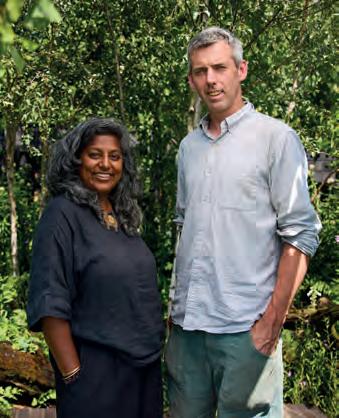
Why was it important to bring this garden to RHS Hampton Court?
Temperate rainforest is so beautiful and people really resonate with the idea of there being something to preserve because while it is so easy to just look at the Amazon, we have so much here that we need to preserve.
What was your RHS Hampton Court highlight? Aside from winning four awards.
What do you think went well with the garden and how did it resonate with the judges?
I think the judges really loved our high level

We've now built up this community of friends and personable relationships that we didn't have before the show, so that's really special. We’ve met people I could imagine coming round for dinner!
Mike McMahon Studio
Email: info@mikemcmahonstudio.com
Phone: +44(0)207 0888 045 mikemcmahonstudio.com
